Home » Posts tagged 'asterisk' (Page 47)
Tag Archives: asterisk
Twofer Tuesday: Incredible PBX for RasPBX on BeagleBone Black and Raspberry Pi

We never were big fans of unfinished projects. And with Festivus behind us and Christmas tomorrow, it seemed only fitting to celebrate with a Twofer Tuesday Encore. Whether you like ’em or hate ’em, Google’s free text-to-speech engine is a big deal. It’s as close to perfect as any commercial product you can buy. So getting it to work with the BeagleBone® Black was really important for those of us that believe the BeagleBone Black is a near perfect telephony platform for home users and SOHO businesses. With this week’s release of Incredible PBX™ 4.11.3 for the RasPBX™, the GoogleTTS engine finally is available in all its glory on both the Raspberry Pi® and BeagleBone Black platforms. At $45 and sporting a "Made in the USA" moniker, the BeagleBone’s only real competition is the Raspberry Pi which has roughly a third the performance for VoIP-related tasks. Finding a BeagleBone Black has not been the easiest thing to accomplish either. They have sprung up five or six times over the past two weeks only to be snarfed up in a couple of hours. We have a PIAF Forum thread that will keep you apprised of the latest sightings or just follow us on Twitter. As with the early days of the Raspberry Pi, price gouging is alive and well so we’ll leave it to you to decide what your budget can tolerate. Our recommendation is hold your nose and pay the extra $15. The BeagleBone Black is worth it!
NEWS FLASH: The all-new Incredible PBX release for Raspberry Pi 2 is now available.
There’s more Black news this week as well. PIAF-Black™ now ushers in the next generation of Asterisk® with the official release of Asterisk 12.0.0. You can download the latest 32-bit or 64-bit PIAF™ ISOs from SourceForge. Then pick your favorite flavor of Asterisk to install. It’s that easy! New torrents were released this week as well thanks to our good friend, Isaac McDonald. Torrents are available for the latest PIAF 2.0.6.5.0 ISOs as well as two virtual machine builds for PIAF-Green™ with FreePBX™ 2.11 and Incredible PBX 11. Just visit the PIAF web site to grab your favorite torrent. Merry Christmas everybody!

For long time Nerd Vittles readers, you may recall that we built the original Incredible PBX™ for Raspberry Pi® (aka Incredible Pi) using much of the development platform pioneered by Gernot Bauer of RasPBX™ fame. In the early days of Gernot’s project, we just couldn’t get the necessary pieces in place on his platform to support Incredible PBX so we temporarily forked his terrific work in order to get Incredible Pi out the door quickly. That was then, and this is now as they say. RasPBX has grown in popularity because of the untiring efforts of Gernot & Co. in continually improving the platform. And six months ago, RasPBX was ported to the BeagleBone Black. Don’t be misled by its tiny footprint. The BeagleBone Black1 provides nearly triple the performance of a $35 Raspberry Pi for an extra $10 to $25 hardware investment depending upon where you buy the board. The rainbow case is a few cents more. 😉
Let us cut to the chase. Run, don’t walk, to buy a BeagleBone Black! It’s that good. If Amazon is sold out, here is a link to other suppliers. See also this thread on the PIAF Forum for the latest availability news. In terms of performance, we would be hard-pressed to distinguish the BeagleBone Black’s performance from an identical Asterisk® and FreePBX®-based system running on the Intel® Atom® platform. The performance boost is that dramatic. So a few weeks ago we decided to take another look at the RasPBX platforms with the goal of porting Incredible PBX in much the same way that we currently provide the add-on for PBX in a Flash™ builds. The advantage for us is that it gets us out of the hardware business and lets us concentrate on building better VoIP application software. The advantage for you is it gives you additional choices, and they’re all still free!
UPDATE: Good News and More Good News. Everything covered below works flawlessly on the Raspberry Pi and BeagleBone Black platforms.

Nerd Vittles Demo IVR Options
1 – Call by Name (say "Delta Airlines" or "American Airlines" to try it out)
2 – MeetMe Conference (password is 1234)
3 – Wolfram Alpha (say "What planes are overhead?")
4 – Lenny (The Telemarketer’s Worst Nightmare)
5 – Today’s News Headlines
6 – Weather Forecast (say the city and state, province, or country)
7 – Today in History
8 – Speak to a Real Person (or maybe just voicemail if we’re out)
Overview of Incredible PBX for RasPBX. Let’s quickly run down the new feature set for Incredible PBX 4.11.3 on the RasPBX platform. With the demise of Google Voice less than six months away, we thought it was important to begin offering some additional choices. With this build, you’ll have a dozen preconfigured VoIP trunks from the best providers in the business to choose from. Most offer outbound calls in the U.S. and Canada for a penny or less per minute. And many offer DID trunks with unlimited inbound calls for under $5 a month. Several offer free SIP URIs, or free U.S. DIDs, or free iNum DIDs for unlimited free calling worldwide. You’ll find lots of tips and suggestions in the Providers section of the PIAF™ Forum. Once you’ve signed up with one or more providers, all you have to do is plug in your credentials and enable the desired trunks in FreePBX. It only takes a few seconds.

We also wanted to provide a robust collection of Asterisk applications that let you bring up a fully-functional, feature-rich VoIP platform in a matter of minutes. As with all Incredible PBX builds, this release activates the Flite text-to-speech engine as well as Google’s TTS and STT interfaces. The Baker’s Dozen VoIP applications we’ve chosen for this initial release include free CallerID Name lookups for incoming calls, Voice Dialing with speech-to-text (STT) capability as well as Speed Dials, Yahoo News and Weather reports with text-to-speech (TTS) translation of the Yahoo news feeds, Weather Reports by ZIP code from the National Weather Service, MeetMe conferencing by simply dialing an extension, Telephone Reminders and Hotel-Style Wakeup Calls (both accessible by phone or via FreePBX GUI), Today in History, SMS messaging, Wolfram Alpha, and our versatile AsteriDex contacts database. We’ve also integrated the Incredible PBX automatic update service into the RasPBX build. Just log into your server once in a while, and the rest is automagic. You also get email delivery of voicemails in MP3 format so that you can play back your messages with almost any email client. Finally, there’s a new status application to tell you everything you want to know about your RasPBX server in a single screen.
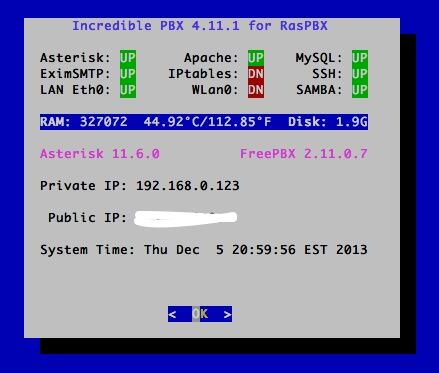
Getting Started. Incredible PBX for RasPBX is basically a scripted installer. It assumes you already have a functioning RasPBX device. The only gotcha is your RasPBX system needs to be freshly created with no customization. This is important because, as part of the installation procedure, Incredible PBX loads a 15MB image snapshot that overwrites all of your Asterisk, FreePBX, and MySQL configurations. If you have previously customized your setup or added features such as faxing, those will get wiped out during the Incredible PBX installation process. Bottom Line: Start by creating a new RasPBX SD image for use with Incredible PBX. Boot RasPBX and log in as root. Download and run the Incredible PBX installer. Once the Incredible PBX install is complete, customize your new system as desired. While nothing is 100% bullet-proof, we’ve taken pains to design Incredible PBX in such a way that it can coexist with future updates to RasPBX deployed through the raspbx-upgrade utility. And Incredible PBX has its own update utility, update-my-raspbx, which is run automatically when you log into your server as root. Finally, we are confident that this new Incredible PBX release is stable; however, it is version 1.0 software and should be treated as such at least through the end of 2013. Please report any bugs you discover on the PIAF Forum, and we will attempt to provide timely fixes.
Installing Incredible PBX. As noted, we’re assuming you already have created a fresh SD card with your RasPBX image. If not, start with the first four steps only of the excellent tutorials for the Raspberry Pi or BeagleBone Black. Next, boot your system from the SD card and log in with username root and password raspberry or beaglebone depending upon your hardware platform. Be sure you have a working Internet connection for your hardware. Then proceed with the Incredible PBX installation procedure below:
cd /
wget http://incrediblepbx.com/incrediblepbx11-raspbx.gz
gunzip incrediblepbx11-raspbx.gz
chmod +x incrediblepbx11-raspbx
./incrediblepbx11-raspbx
Hang around for the first couple minutes of the install. You’ll be prompted to type a Y as part of the raspbx-upgrade procedure. Once you get past that prompt, you can go have a cup of coffee while the installation procedure continues. It takes about 15-30 minutes to complete depending upon the speed of your Internet connection. Once the base install finishes, the update-passwords script will be launched. It’s imperative that you reset all of your passwords with very secure passwords immediately. This includes the root password, the FreePBX and ARI admin passwords, the extension 701 password, the extension 701 voicemail password, the email delivery address for extension 701, and the telephone reminders password for scheduling reminders by phone. Just fill in the blanks, and the script will do the heavy lifting.
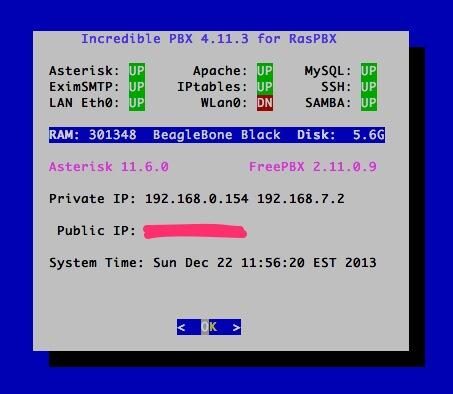
Asterisk Security. Once the Incredible PBX install completes, what you still have is an Incredibly Insecure PBX. Unless you’ve already done so, make certain that Incredible PBX is repositioned behind a hardware-based firewall with no Internet port exposure! This is very important. Neither Asterisk nor FreePBX was designed for direct exposure to the Internet. Before you do anything else, read our Primer on Asterisk Security. Remember, it’s your phone bill.
UPDATE: Travelin’ Man 3 Now Implemented. Beginning with Incredible PBX 4.11.3, IPtables WhiteList security was added to the RasPBX BeagleBone Black platform. And version 4.11.4 released on 1-4-14 added it to the Raspberry Pi edition of RasPBX as well. For the nuts and bolts of how the IPtables firewall and WhiteLists work, read the Travelin’ Man 3 tutorial. Do NOT install the application! It’s already there. We still recommend that you always run your server behind a hardware-based firewall. Travelin’ Man 3 just adds an extra layer of protection. Think of it as a second condom without the pain. 😉
As initially configured, IPtables is set up to allow all incoming and outgoing traffic. It will display as DN in the status display. You have a couple of options. If you only want to allow incoming traffic from phones and users on your private LAN while permitting registered SIP and IAX trunk connections from anywhere, then log into your server as root and execute this command:
cp /root/iptables.lanonly /etc/network/iptables
If you want to further lock down your server and manage all external connections from outside your LAN, run: /root/secure-iptables. As configured, IPtables never blocks internal LAN traffic. By running secure-iptables, you get to set one "safe" external IP address for access to your server in addition to automatically configuring the safe IP addresses of a dozen SIP providers. You then can add additional IP addresses to your WhiteList by running /root/add-ip or /root/add-fqdn. You can delete providers with /root/del-acct. Check the status of your IPtables setup at any time with this command: iptables-status. Restart/reload IPtables settings using only this command: iptables-restart. If you use the traditional IPtables reload procedure, you will permanently erase any fully-qualified domain names in your IPtables configuration and convert them (permanently) to IP addresses. Don’t do it! Always use iptables-restart. Never erase files in /root with the .iptables extension. This is how Travelin’ Man 3 keeps track of your WhiteList entries so that you can delete as desired. For further details, read the Travelin’ Man 3 article.
Overclocking the Raspberry Pi. On the Raspberry Pi platform only, to enable overclocking at your own risk, run: raspi-config. Overclocking works for us. YMMV! The key is a good power supply. Even though the kernel now monitors CPU temperature and manages overclocking, it’s always nice to see for yourself. To monitor the CPU temperature, just run the status program which provides a current snapshot anytime.
Resizing an SD Card. On both the BeagleBone Black and Raspberry Pi platforms, you can resize (expand) the default partition to accommodate a larger SD card. On the Raspberry Pi, the default partition is 4GB. On the BeagleBone Black, it’s only 2GB. To resize the partition to make use of a larger SD card on a Raspberry Pi, choose the resize option after running raspi-config. Then reboot. The BeagleBone Black is a different beast. While we don’t recommend it, you can actually run Incredible PBX using the internal 2GB eMMC memory board rather than an external Micro SD card. Gernot’s documentation will walk you through how to do it. While it is screaming fast compared to an SD card, you’ll only have 371MB of breathing room so it means constant monitoring of your log files and minimal use of functions that consume disk space. Or you could create a cron job to run daily and use a script like ours:
#!/bin/bash
cd /var/log/asterisk
touch empty.log
chmod 664 empty.log
chown asterisk:asterisk empty.log
cp empty.log freepbx_dbug
cp empty.log freepbx_debug
cp empty.log freepbx.log
cp empty.log full
cd ..
rm *.0*
rm *.1*
rm /tmp/ggl*
We much prefer at least an 8GB Type 4 SD card for Incredible PBX. On the BeagleBone Black, we’ve added the resize-partition script in the /root folder. Just run it after booting from your Micro SD card.
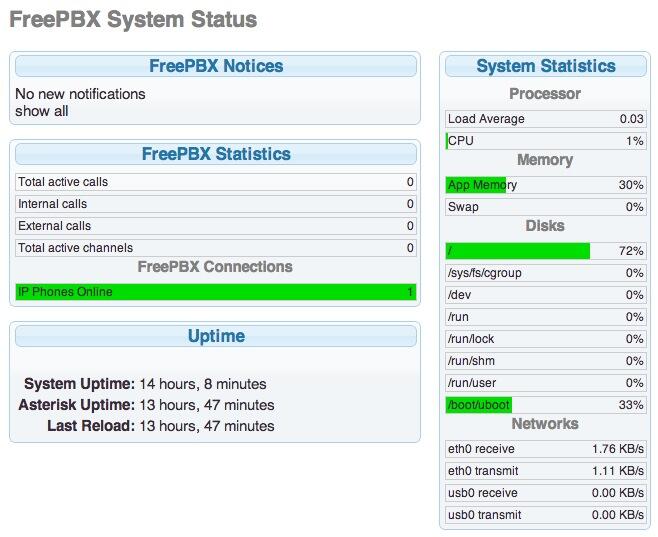
Setting Up Google Voice. If you want free calling in the U.S. and Canada for the next five months, then you’ll need a Google Voice account, and you’ll need one dedicated to Incredible PBX, or it won’t work. Log out after setting up the new Google Voice account! Also note that Google Voice will cease to function on May 15, 2014. Read all about it here.
- Register for Google Voice account (no funky characters in your password!)
- Enable Google Chat as Phone Destination
- Configure Google Voice Calls Settings:
- Call Screening – OFF
- Call Presentation – OFF
- Caller ID (In) – Display Caller’s Number
- Caller ID (Out) – Don’t Change Anything
- Do Not Disturb – OFF
- Call Options (Enable Recording) – OFF
- Global Spam Filtering – ON
- Place test call in and out using GMail Call Phone
Accessing Incredible PBX By GUI. You don’t have to be a Linux guru to use Incredible PBX. In fact, we’re just about finished with the Linux command prompt, but stay logged in until we finish a few more steps below. Most of your configuration of Incredible PBX will be performed using the FreePBX Web GUI.
If you’re new to Asterisk and FreePBX, here’s the one paragraph primer on what needs to happen before you can make free calls with Google Voice. You’ll obviously need a free Google Voice account. This gets you a phone number for people to call you and a vehicle to place calls to plain old telephones throughout the U.S. and Canada at no cost. You’ll also need a softphone or SIP phone to actually place and receive calls. YATE makes a free softphone for PCs, Macs, and Linux machines so download your favorite and install it on your desktop. Phones connect to extensions in FreePBX to work with Incredible PBX. Extensions talk to trunks (like Google Voice) to make and receive calls. FreePBX uses outbound routes to direct outgoing calls from extensions to trunks, and FreePBX uses inbound routes to route incoming calls from trunks to extensions to make your phones ring. In a nutshell, that’s how a PBX works. There are lots of bells and whistles that you can explore down the road.
Let’s get started. Using a browser, enter the IP address of your server or just use http://raspbx.local as the address. Choose FreePBX Administration. When prompted for a username and password, use admin for the username and whatever FreePBX password you set up when you initially configured your server above. If you ever forget your credentials, just run /root/update-passwords again to reset them.
Changing FreePBX admin Password and Default Email. From the main FreePBX GUI, click Admin => Administrators. Click on admin user in the far-right column. Enter a new Password and click Submit Changes button. We did this in update-passwords, but now you’ll know how to do it from with the FreePBX GUI as well. Click Apply Config button. Be sure to set your default email address in the right margin of Admin -> Module Admin and save your entry. By doing this, you’ll get periodic notices of FreePBX updates. It’s a good idea to stay current with these. They are generally well tested before release.
Activating a Google Voice Trunk. To create a Trunk in FreePBX to handle calls to and from Google Voice, you’ll need three pieces of information from the Google Voice account you set up above: the 10-digit Google Voice phone number, your Google Voice account name, and your Google Voice password. Choose Connectivity -> Google Voice (Motif) from the FreePBX GUI. The following form will appear:
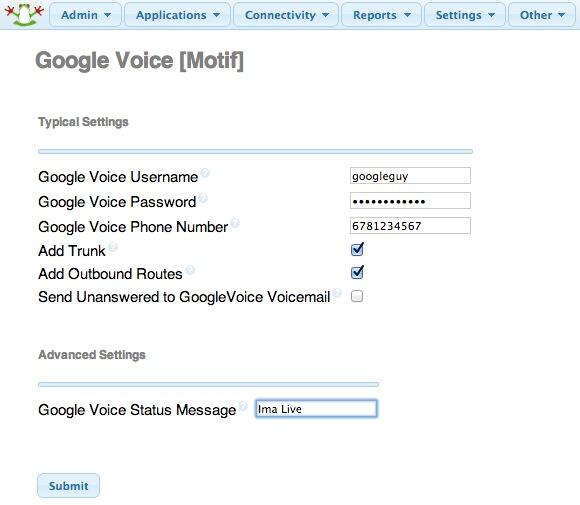
Fill in the blanks with your information and check only the top 2 boxes. If your Google Voice account name ends in @gmail.com, leave that out. Otherwise, include the full email address. Then click Submit Changes and Apply Config.
There’s one more step or your Google Voice account won’t work reliably with Incredible PBX! From the Linux command prompt while logged into your server as root, restart Asterisk: amportal restart
Setting a Destination for Incoming Calls. Now that you’ve created your Google Voice Trunk, we need to tell FreePBX how to process inbound calls when someone dials your Google Voice number. There are any number of choices. You could simply ring an extension such as 700 which we’ve already set up for you. Or you could ring multiple extensions by first creating a Ring Group which is just a list of extension numbers. Or you could direct incoming calls to an Interactive Voice Response (IVR) system.
By default, Incredible PBX is configured to route all incoming calls to extension 701. You can change this whenever you like by choosing Connectivity -> Inbound Routes -> Default. In the Set Destination section of the form, change the target to your desired destination for the incoming calls. Then click Submit and Apply Config.
Changing Extension Passwords. From the main FreePBX GUI, choose Applications -> Extensions. Then click on 701 in the Extension List on the right side of your display. You’ll see a form that looks like this:

We’ve already made these changes using update-passwords, but here’s how to do it in the FreePBX GUI. The extension secret needs to be a combination of letters and numbers. The Voicemail Password needs to be all numbers, preferably six or more. Replace the existing passwords with your own (very secure) entries. You also need to lock down this extension so that it is only accessible from devices on your private LAN. You do that with the deny and permit entries which currently are filled with zeroes. Leave the deny entry the way it is which tells Incredible PBX to block everybody except those allowed in the permit entry below. For the permit, we need the first three octets of your private LAN address, e.g. if your LAN is 192.168.0.something then the permit entry will be 192.168.0.0/255.255.255.0.
Finally, you need to insert your actual email address in the Voicemail section so that voicemails can be delivered to you when someone leaves a message. You can also include a pager email address if you want a text message alert with incoming voicemails. If you want the voicemails to automatically be deleted from the server after they are emailed to you (a good idea considering the disk storage limitations of an SDHC card), change the Delete Voicemail option from No to Yes. That’s it. Now save your settings by clicking the Submit button. Then reload the dialplan by clicking on the red prompt when it appears.
In case you’re curious, unless you’ve chosen to automatically delete voicemails after emailing them, you can retrieve your voicemails for extension 701 by dialing *98701 from any extension on your phone system. You’ll be prompted to enter the voicemail password you set up. And you can leave a voicemail for someone by dialing their extension number preceded by an asterisk, e.g. *701 would let someone leave you a voicemail without actually calling you.
Eliminating Audio and DTMF Problems. You can avoid one-way audio on calls and touchtones that don’t work with these simple settings in FreePBX: Settings -> Asterisk SIP Settings. Just plug in your public IP address and your private IP subnet. Then set ULAW as the only Audio Codec.
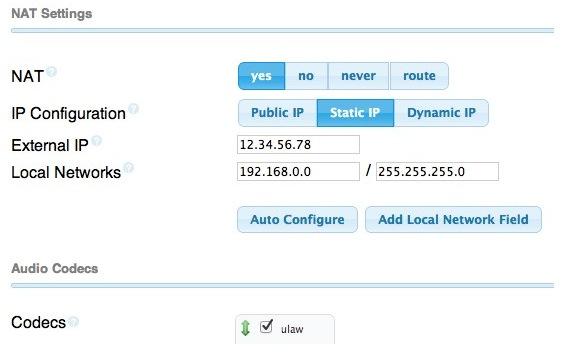
Setting Up a Desktop Softphone. Incredible PBX supports all kinds of telephones, but we’ll start with the easy (free) one today. You can move on to "real phones" once you’re smitten with the VoIP bug. For today, you’ll need to download a softphone to your desktop PC or Mac.
As we mentioned, the easiest way to get started with Incredible PBX is to set up a YATE softphone on your Desktop computer. Versions are available at no cost for Macs, PCs, and Linux machines. Just download the appropriate one and install it from this link. Once installed, it’s a simple matter to plug in your extension 701 credentials and start making calls. Run the application and choose Settings -> Accounts and click the New button. Fill in the blanks using the IP address of Incredible PBX, 701 for your account name, and whatever password you created for the extension. Click OK.
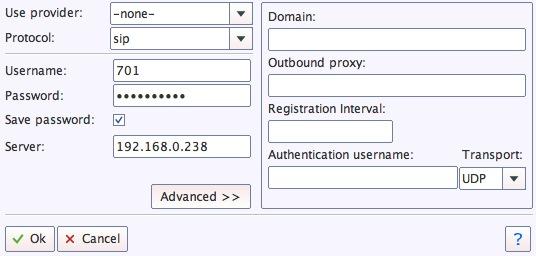
Once you are registered to extension 701, close the Account window. Then click on YATE’s Telephony Tab and place your first call. It’s that easy!
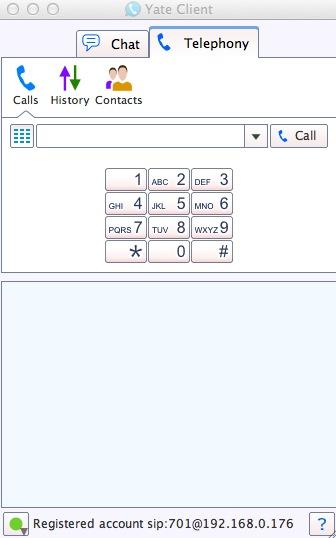
Incredible Trunks. When you’re ready to try some other SIP providers, we’ve done the hard work for you by providing the setups for a dozen terrific providers. All you have to do is sign up for service on their sites, enable the desired Trunks in FreePBX, and plug in your credentials. Here is a quick Cheat Sheet courtesy of Kristian Hare, who translated the Incredible PBX setups into a spreadsheet. Just click on the image below to open it in a new window. Then click on the redisplayed image to enlarge it.

Adding WiFi Support. This is covered on Gernot’s web site, but we’ll address it just for ease of reference. The most important detail is don’t get creative with your choice of USB WiFi adapters. The Edimax EW-7811Un works so use it. It’s about $10 from Amazon with free 2-day Prime shipping. Next, edit /etc/network/interfaces and add the following lines using the name of your WiFi network as well as your password "in quotes":
auto wlan0
allow-hotplug wlan0
iface wlan0 inet dhcp
wpa-ssid your-ssid-here-no-quotes
wpa-psk "your-passphrase-here-with-quotes"
Next, reboot your server and login as root. Your USB WiFi adapter should be lit. Running ifconfig should display an IP address for wlan0. ifdown eth0 will shut down your wired connection. Then restart Asterisk to switch to WiFi: amportal restart.
Shutting Down Your Server. Last but not least, never just pull the plug when you want to shut down your server, or you may end up with corrupted MySQL databases. Then nothing will run. Instead, log into your server as root, and issue the following commands: amportal stop and then shutdown -h now.
The Incredible PBX 4.11.3 Software Collection
Now for the fun stuff. For most folks getting started with Asterisk and FreePBX, the steepest learning curve is moving from a functioning system to one that can actually do cool stuff. Text-to-speech and speech-to-text applications and IVRs and call management and conferencing and click to dial and SMS messaging and faxing are what separate the men from the boys on the Asterisk playing field. And that’s where Incredible PBX really shines. You don’t have to do anything but choose the apps you want to deploy for yourself or your users. Everything is already in place. If you don’t use it, it doesn’t consume any computing resources. So it’s not like the bloatware of decades ago that was always sitting in memory wasting your computing cycles. Here’s a quick thumbnail on each of the applications that’s included in Incredible PBX for RasPBX. You can include almost all of these applications in your IVRs so that callers can make a selection from a list of menu choices. We’ve included the appropriate FreePBX links below. On many of the apps, we’ve also included links to Nerd Vittles or PIAF Forum tutorials for more detailed documentation when you need it.
News Headlines from Yahoo
How It Works. Dial 951. Listen to latest news headlines from Yahoo.
Prerequisites: Uses preconfigured Google TTS.
Setup Required: None
IVR/Dialplan Integration: Misc Destination -> News Headlines
Worldwide Weather Forecasts by City from Yahoo
How It Works. Dial 949. Say the name of a city and state/country for weather report desired. Press #. Listen.
Prerequisites: Uses preconfigured Google STT for query and Google TTS for playback.
Setup Required: None
IVR/Dialplan Integration: Misc Destination -> Weather by City
Worldwide Weather Forecasts by City from Weather Underground
How It Works. Dial 949. Say the name of a city and state/country for weather report desired. Press #. Listen.
Prerequisites: Requires free Weather Underground API key. Uses preconfigured Google STT for query and Google TTS for playback.
Setup Required: Obtain free Weather Underground API key. In /var/lib/asterisk/agi-bin, insert your API key in $apikey of nv-weather-underground.php. Copy nv-weather-underground.php to nv-weather-google.php. Replaces Yahoo Weather by City and provides best available free weather reports.
Limitations. Free account supports up to 10 calls per minute and up to 500 calls per day.
IVR/Dialplan Integration: Misc Destination -> Weather by City
U.S. Weather Forecasts by ZIP Code from National Weather Service
How It Works. Dial 947 (Z-I-P). Enter 5-digit ZIP code for weather report desired. Listen.
Prerequisites: Uses preconfigured Flite TTS to deliver weather report.
Setup Required: None
IVR/Dialplan Integration: Misc Destination -> Weather by ZIP
Today in History from HistoryOrb.com
How It Works. Dial 86329 (T-O-D-A-Y). Listen to today’s important events in history.
Prerequisites: Uses preconfigured Flite and Google TTS to deliver report.
Setup Required: None
IVR/Dialplan Integration: Misc Destination -> Today in History
Schedule Reminders by Phone and Web
How It Works. Dial 123. Enter password. Schedule a reminder or recurring reminder.
Web Interface. FreePBX -> Other -> Reminders to schedule, review, or delete existing reminders.
Prerequisites: Requires configuration of password with /root/update-passwords.
Setup Required: None. Complete tutorial available here.
IVR/Dialplan Integration: Misc Destination -> Reminders
Hotel-Style Wakeup Calls
How It Works. Dial *68. Schedule a wakeup call just like in the hotel.
Web Interface. FreePBX -> Applications -> Wake Up Calls to schedule and configure wakeup calls.
Prerequisites: None.
Setup Required: None. Complete tutorial available here.
IVR/Dialplan Integration: Misc Destination -> Wakeup Calls
Time of Day
How It Works. Dial *61. Check the time just like in the Ma Bell era.
Prerequisites: None.
Setup Required: None.
IVR/Dialplan Integration: Misc Destination -> Time of Day
AsteriDex Phone Book and RoboDialer
How It Works. Open AsteriDex. Populate entries. Set click-to-dial extension. Click on person/company to call. Answer ringing call on your designated click-to-dial extension. Wait for called party to be connected.
Web Interface. FreePBX -> Other -> AsteriDex to update directory and to place click-to-dial calls.
Prerequisites: Populate the AsteriDex directory with your favorite people and places to call.
Setup Required: Complete tutorial for AsteriDex is available here. Import Google Contacts. Import Outlook Contacts. Import from Exchange Server. Import Mac Address Book or CSV Contacts.
AsteriDex Voice Dialer
How It Works. Dial 411. Say the name of person or company to call. Entry is looked up from AsteriDex and called.
Web Interface. FreePBX -> Other -> AsteriDex to update directory and to place click-to-dial calls.
Prerequisites: Populate the AsteriDex directory with your favorite people and places to call. Uses Google STT.
Setup Required: None. Complete tutorial for AsteriDex is available here.
IVR/Dialplan Integration: Misc Destination -> Voice Dialer
AsteriDex Speed Dialing Duo
How It Works. Dial 412. Enter Speed Dial code of person/company. Entry is looked up from AsteriDex and called.
Alternative. Dial 000 + Speed Dial code. Entry is looked up from AsteriDex and called.
Web Interface. FreePBX -> Other -> AsteriDex to update directory and to place click-to-dial calls.
Prerequisites: Populate the AsteriDex directory with your favorite people and places to call. Include a DialCode for speed dial.
Setup Required: None. Complete tutorial for AsteriDex is available here.
IVR/Dialplan Integration: Misc Destination -> Call by Code
SMS Dictator
How It Works. Dial 767 (S-M-S). Say either the name of an AsteriDex entry or enter an SMS phone number to call. Dictate a message to be sent via Google SMS. Your message is converted to text and delivered via Google SMS.
Prerequisites: Requires Google Voice account and SMS Dictator setup. Uses preconfigured Google STT.
Setup Required: Before first use, sign up for a Google Voice account that can be dedicated to Incredible PBX use. Run install-smsdictator.sh in /root to configure SMS Dictator with your credentials. Complete documentation available here. May cease to function on May 15, 2014.
IVR/Dialplan Integration: Misc Destination -> SMS Dictator
SMS Message Blasting
How It Works. Run the smsblast script in /root to deliver an SMS text message stored in smsmsg.txt to all of the SMS recipients configured in smslist.txt.
Prerequisites: Requires Google Voice account and SMS Blaster setup.
Setup Required: Before first use, sign up for a Google Voice account that can be dedicated to Incredible PBX use. Untar smsblast.tgz in /root: tar zxvf smsblast.tgz. Edit smsblast and insert your Google Voice credentials. Edit smsmsg.txt and type your SMS message to be sent. Edit smslist.txt and prepare your SMS message recipient list. Then run smsblast to deliver your messages. May cease to function on May 15, 2014.
Wolfram Alpha
How It Works. Dial 4747. Say your query for Wolfram Alpha. Examples here. Listen to results.
Prerequisites: Requires free Wolfram Alpha account and setup. Uses preconfigured Google STT and Flite.
Limitations: Free account restricted to 2,000 queries per month.
Setup Required: Before first use, sign up for a Wolfram Alpha account and obtain AppID. Then configure Wolfram Alpha with your credentials by running install-wolframalpha.sh in /root. Complete documentation available here.
IVR/Dialplan Integration: Misc Destination -> Wolfram Alpha
MeetMe Conferencing
How It Works. Dial 2663 (C-O-N-F). Enter user or admin PIN for conference room. Participate in conference call.
Prerequisites: None.
Setup Required: Configure your participant and admin PINs: FreePBX -> Applications -> Conferences -> 2663
IVR/Dialplan Integration: Conferences -> 2663
Telemarketers and Old Girl Friends: Meet Lenny
How It Works. Dial 53669 (L-E-N-N-Y). An entertaining solution for SPAM calls. Also configured as destination for callers on your BlackList.
Prerequisites: None. Read all about Lenny here.
Setup Required: Add 10-digit numbers of spammers to Admin -> Blacklist or dial *32 to BlackList your last caller.
IVR/Dialplan Integration: Extension -> 53669

HylaFax/AvantFax Fax Server
How It Works. Dial 329 (F-A-X). Faxing already is available as a module in RasPBX. You can send faxes to Incredible PBX using almost any SIP or Google Voice DID that you’ve dedicated to faxing.
Prerequisites: Read the Fax Gateway tutorial on Gernot’s web site.
Setup Required: After installing Incredible PBX, run the install-fax script to set up the HylaFax/AvantFax servers. When prompted whether to add an extension, type Y. We recommend 329 for the extension number. It spells F-A-X and makes it easy for everyone to remember the dedicated fax extension on your system. Specify an email address for delivery of the incoming faxes. Switch to FreePBX and add an Incoming Route for the DID that you’ve dedicated to incoming faxes. Specify 329 as the destination. To add additional fax numbers with additional email destinations, run add-fax-extension.
IVR/Dialplan Integration: Extension -> 329
Bluetooth Proximity Detection
Finally, if you really want to impress your friends, buy yourself a cheap Bluetooth adapter and set up a Proximity Detection System that will forward your Asterisk calls to your cellphone when you’re away from your desk. This Nerd Vittles article will walk you through the quick setup process. Before you begin, just install bluez on your Raspberry Pi or BeagleBone Black: apt-get install bluez.
A Word About Flite TTS
We’ve included FLITE as the generic text-to-speech engine for Asterisk. The quality of Google TTS is much better, but we never know how long Google apps will continue to function. Because FLITE is actually integrated into Asterisk, it is susceptible to breakage if a RasPBX upgrade installs a new release of Asterisk. If this happens, you’ll know when FLITE goes silent. You can also run the following command from the Linux command prompt to check it. If you don’t get a page of FLITE information, it’s broken. 🙂
asterisk -rx "core show application like flite"
Don’t fret if FLITE breaks. Here’s how to fix it:
cd /usr/src/flite
make clean
make
make install
amportal restart
A Word About MySQL
To eliminate the need to maintain separate versions of Incredible PBX for RasPBX on the Raspberry Pi and BeagleBone Black platforms, we’ve changed the MySQL password on both platforms to raspberry. Originally, beaglebone was the assigned password on the BeagleBone Black RasPBX implementation.
 Support Issues. With any application as sophisticated as this one, you’re bound to have questions. Blog comments are a terrible place to handle support issues although we welcome general comments about our articles and software. If you have particular support issues, we encourage you to get actively involved in the PBX in a Flash Forums. It’s the best Asterisk tech support site in the business, and it’s all free! Please have a look and post your support questions there. Unlike some forums, ours is extremely friendly and is supported by literally hundreds of Asterisk gurus and thousands of ordinary users just like you. You won’t have to wait long for a courteous response.
Support Issues. With any application as sophisticated as this one, you’re bound to have questions. Blog comments are a terrible place to handle support issues although we welcome general comments about our articles and software. If you have particular support issues, we encourage you to get actively involved in the PBX in a Flash Forums. It’s the best Asterisk tech support site in the business, and it’s all free! Please have a look and post your support questions there. Unlike some forums, ours is extremely friendly and is supported by literally hundreds of Asterisk gurus and thousands of ordinary users just like you. You won’t have to wait long for a courteous response.
Originally published: Tuesday, December 10, 2013 Updated: Tuesday, December 24, 2013

Need help with Asterisk? Visit the PBX in a Flash Forum.
Special Thanks to Our Generous Sponsors
FULL DISCLOSURE: ClearlyIP, Skyetel, Vitelity, DigitalOcean, Vultr, VoIP.ms, 3CX, Sangoma, TelecomsXchange and VitalPBX have provided financial support to Nerd Vittles and our open source projects through advertising, referral revenue, and/or merchandise. As an Amazon Associate and Best Buy Affiliate, we also earn from qualifying purchases. We’ve chosen these providers not the other way around. Our decisions are based upon their corporate reputation and the quality of their offerings and pricing. Our recommendations regarding technology are reached without regard to financial compensation except in situations in which comparable products at comparable pricing are available from multiple sources. In this limited case, we support our sponsors because our sponsors support us.
 BOGO Bonaza: Enjoy state-of-the-art VoIP service with a $10 credit and half-price SIP service on up to $500 of Skyetel trunking with free number porting when you fund your Skyetel account. No limits on number of simultaneous calls. Quadruple data center redundancy. $25 monthly minimum spend required. Tutorial and sign up details are here.
BOGO Bonaza: Enjoy state-of-the-art VoIP service with a $10 credit and half-price SIP service on up to $500 of Skyetel trunking with free number porting when you fund your Skyetel account. No limits on number of simultaneous calls. Quadruple data center redundancy. $25 monthly minimum spend required. Tutorial and sign up details are here.
 The lynchpin of Incredible PBX 2020 and beyond is ClearlyIP components which bring management of FreePBX modules and SIP phone integration to a level never before available with any other Asterisk distribution. And now you can configure and reconfigure your new Incredible PBX phones from the convenience of the Incredible PBX GUI.
The lynchpin of Incredible PBX 2020 and beyond is ClearlyIP components which bring management of FreePBX modules and SIP phone integration to a level never before available with any other Asterisk distribution. And now you can configure and reconfigure your new Incredible PBX phones from the convenience of the Incredible PBX GUI.
 VitalPBX is perhaps the fastest-growing PBX offering based upon Asterisk with an installed presence in more than 100 countries worldwide. VitalPBX has generously provided a customized White Label version of Incredible PBX tailored for use with all Incredible PBX and VitalPBX custom applications. Follow this link for a free test drive!
VitalPBX is perhaps the fastest-growing PBX offering based upon Asterisk with an installed presence in more than 100 countries worldwide. VitalPBX has generously provided a customized White Label version of Incredible PBX tailored for use with all Incredible PBX and VitalPBX custom applications. Follow this link for a free test drive!
 Special Thanks to Vitelity. Vitelity is now Voyant Communications and has halted new registrations for the time being. Our special thanks to Vitelity for their unwavering financial support over many years and to the many Nerd Vittles readers who continue to enjoy the benefits of their service offerings. We will keep everyone posted on further developments.
Special Thanks to Vitelity. Vitelity is now Voyant Communications and has halted new registrations for the time being. Our special thanks to Vitelity for their unwavering financial support over many years and to the many Nerd Vittles readers who continue to enjoy the benefits of their service offerings. We will keep everyone posted on further developments.
Some Recent Nerd Vittles Articles of Interest…
- Many of our purchase links refer users to Amazon when we find their prices are competitive for the recommended products. Nerd Vittles receives a small referral fee from Amazon to help cover the costs of our blog. We never recommend particular products solely to generate Amazon commissions. However, when pricing is comparable or availability is favorable, we support Amazon because Amazon supports us. [↩]
The Perfect Stocking Stuffer: Incredible PBX for the Raspberry Pi Gets a Facelift
 It’s been a wild ride with the $35 Raspberry Pi®. In late October, sales of the Raspberry Pi topped two million in less than two years. And, if you didn’t already know, the Raspberry Pi makes a near perfect platform for your very own VoIP PBX. It’s less than a ONE HOUR project!
It’s been a wild ride with the $35 Raspberry Pi®. In late October, sales of the Raspberry Pi topped two million in less than two years. And, if you didn’t already know, the Raspberry Pi makes a near perfect platform for your very own VoIP PBX. It’s less than a ONE HOUR project!
[iframe-popup id="3″]
If you’re new to the party, imagine squeezing a 700 mHz ARM processor with 512MB of RAM, 2 USB ports, a 10/100 Ethernet port, an HDMI port, composite video, a separate audio jack, an SDHC card slot, and a micro USB port onto a motherboard the size of a credit card weighing 1.6 ounces. Adding WiFi is as simple as plugging in a USB adapter.
Absolute perfection. Other than the slow write speeds to the sd card (you might add a warning note about that part), I had it swapped over to local extension numbers and trunked to existing asterisk servers in minutes… [I]t doesn’t get any cooler than this! — Scott P.
Trust us when we say the performance of this tiny computer is nothing short of amazing. Can it do everything a $300 dual-core Atom PC can do? No. Can it do 90% of everything for someone whose requirements do not exceed a handful of simultaneous calls at a time but still wants a full-blown PBX for call routing, transcribed voicemails delivered by email, IVRs, music on hold, and text-to-speech and speech-to-text apps for a home, a SOHO office, a Little League team, or a dorm room? Absolutely. As Scott mentioned, configuration changes may take you a few seconds longer than would normally be the case with an Atom-based PC and a hard disk. But, hey, you can have this delivered to your front door in two days with Amazon Prime shipping for just a few bucks more than the original cost of the $35 computer, and you’ll have a fully functional PBX up and running before you can name all of Santa’s reindeer:
[purehtml id=16]
And today we’re pleased to introduce Incredible PBX 3.11.8 for the Raspberry Pi, a turnkey PBX featuring Asterisk® 11 and FreePBX® 2.11 for a near perfect telephony platform. Special thanks to the tens of thousands of pioneers that have given the first dozen iterations of this software a healthy workout over the past year. We couldn’t have done it without you!
What’s New in Incredible PBX 3.11.8? For those of you already running a previous version, here’s a quick thumbnail of the 3.11.8 feature set. As in the past, we’ve tried to mimic as much of the previous build functionality as possible while providing new firmware support for the very latest Raspberry Pi boards. So you still get simple utilities to configure 1GHz overclocking and automatic expansion of the 3.11 image to run on any size SDHC card. But the major addition is implementation of Asterisk’s latest long-term support release, Asterisk 11, which provides an incredibly stable VoIP platform. There also have been some major plumbing enhancements in FreePBX 2.11 to improve its stability and to enhance security. Of course, you still get Google Voice support until May, 15, 2014 with free calling in the U.S. and Canada as well as free faxing and SMS messaging plus most of the Incredible PBX feature set. We’ve also added optional voice transcription and email delivery of MP3 voicemails to smooth the migration to unified messaging. If you want the first 15 seconds of each voicemail transcribed, then issue the following commands after logging into your server as root. Additional documentation is available here.
cd /usr/sbin
mv sendmailmp3 sendmailmp3.notrans
mv /root/sendmailmp3 sendmailmp3
For those running previous Incredible PBX builds that want support for the newer Raspberry Pi boards, there’s a simple fix to upgrade your existing SD card so that it will boot properly with the newer boards. Here’s the link.
Incredible PBX 3.5 and beyond added automatic detection and support of 512MB Raspberry Pi devices without touching anything. Beginning with version 3.7, we added an awesome fax server to Incredible PBX for those with a 512MB board. The complete tutorial is available here. update-my-pi in the /root folder of your server helps to safeguard your system by bringing it up to date with the latest fixes and enhancements. After running it the first time, it gets run automatically whenever you log in as root. For the safety of your server, don’t disable it! It’s free for the first ten updates, and then it’s just $20 a year. We have to eat, too. If you are philosophically opposed to ever spending a dime to support the open source movement, then feel free to load the latest version of Incredible PBX at no cost whenever you like. It will always be free! Then you can restore your settings using the backup and restore feature built into FreePBX.
To enable overclocking at your own risk, run: raspi-config. Overclocking works for us. YMMV! The key is a good power supply. If you’re using an SD card larger than 4GB, version 3.3 and beyond now can resize your partitions on the fly. Just choose the option in raspi-config and reboot. Even though the kernel now monitors CPU temperature and manages overclocking, it’s always nice to see for yourself. To monitor the CPU temperature, just run the status program which provides a current snapshot anytime. Temperature data now is provided on the FreePBX Dashboard as well.
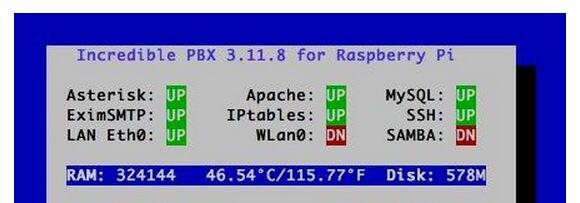
There’s more good news. Networking is much more stable; however, we’ve dropped support for the TP-Link WiFi adapters. If you still have one of these adapters, see this thread on the PIAF Forum for setup instructions. Otherwise you’ll need the recommended AirLink 101 N-150 if you want WiFi capability. In the 3.11 release, your server will automatically attempt to connect to any open WiFi network that it can find. We’ve also added two scripts in /root to let you restart either your wired or wireless network and designate it as the primary network: restart-eth0 and restart-wlan0. Time zone management was also a bit of mess with multiple file settings required to support both Linux and PHP. In the 3.11 release, you’ll be prompted to select your timezone when you first log in as root. The setup script will automatically apply your entry in all the right places. We’ve also replaced SendMail with Exim to simplify the process of using an SMTP mail gateway such as Gmail. The procedure for making the change is documented here.
As part of the 3.11 migration, we’ve also eliminated the pi user account. Everything you need to do to configure Incredible PBX requires root permission. So goodbye sudo. Only the root user account is included, and the default password is raspberry. Change the password when you first log in. New SSH and DUNDI keys now are automatically generated when you first boot your server. The FreePBX Backup and Restore Utility is included in this new build. AsteriDex Speed Dialing has been enhanced for our friends across the Atlantic. Enter 3-digit Dial Codes in AsteriDex, and you can call by dialing 000nnn. In the 3.11 upgrade, Telephone Reminders again work.
X Windows is included in this build. This won’t work with SSH. For a demo slideshow, plug in a real monitor and log in as root. In the /root folder, enter the command: startx. To end the slideshow, press ESCape. To disable the slideshow: mv .xinitrc xinitrc. To add photos, copy .jpg images into /root/slideshow. No mouse is required for the slideshow but, if you run X Windows natively, you’ll need a USB mouse. The SMS Blasting app in /root now supports phone numbers (which use SMS) and email addresses (which use SendMail).
Last but not least, a sophisticated Conference Bridge has been added to Incredible PBX 3.11. If you route one of your inbound DIDs to the predefined IVR, users can press 0 and enter 1234 for the conference PIN to join the conference. Local extensions simply dial C-O-N-F. We’ve already tested a 9-person conference call with excellent results. But don’t take our word for it. Try it for yourself. Just call our demo Raspberry Pi AutoAttendant and take the Conference Bridge and a handful of other Incredible PBX™ apps for a test drive:

And here’s what the conference call looked like in the FreePBX Dashboard:

So you don’t have to jump around between articles, we’ve put together this Quick Start Guide that tells you everything you need to know to get up and running in about an hour. Most of that time will be consumed copying the Incredible Pi image to an SD card. So there’s plenty of time for lunch during the hour. Once your system is running and you’ve completed the setup steps below, then jump over to the application tutorial which explains how to use every one of the 35+ Incredible PBX Apps for the $35 Raspberry Pi.
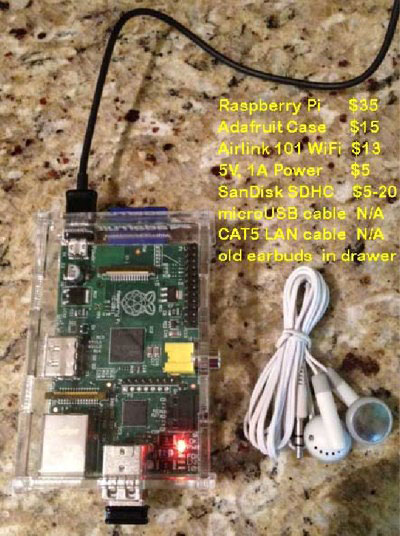
What to Buy. Here’s everything you need to get started.1 The case is optional. Yes, you can run the Raspberry Pi sitting on your desk with no case. It’s only 5 volts. WiFi is also optional. There’s a 10/100 port on the Raspberry Pi that gives you all the networking you need. Here are the links to buy the pieces. You also need a CAT5 cable and either a spare PC or Mac with Putty or SSH and a pair of earbuds or an HDMI cable to connect to a TV or monitor and a USB keyboard.
- $35 512MB Raspberry Pi from MCM or Newark or Amazon
- $10 Power Adapter (this one is rock solid!)
- $10 SanDisk 16GB SDHC Type 4 card
- $15 Adafruit Acrylic Case
- $13 AirLink 101 N150 WiFi Adapter or Adafruit Mini WiFi Adapter
Setting Up Google Voice. If you want free calling in the U.S. and Canada, then you’ll need a Google Voice account, and you’ll need one dedicated to Incredible Pi, or it won’t work. Log out after setting up the new Google Voice account! Also note that Google Voice will cease to function on May 15, 2014. You can read all about it here.
- Register for Google Voice account (no funky characters in your password!)
- Enable Google Chat as Phone Destination
- Configure Google Voice Calls Settings:
- Call Screening – OFF
- Call Presentation – OFF
- Caller ID (In) – Display Caller’s Number
- Caller ID (Out) – Don’t Change Anything
- Do Not Disturb – OFF
- Call Options (Enable Recording) – OFF
- Global Spam Filtering – ON
- Place test call in and out using GMail Call Phone
Baking Your Incredible Pi. The disk drive for the Raspberry Pi is an SD card. So what you need to do is download Incredible Pi and copy the image onto an SDHC card. Mac and Linux installers are included. For Windows, just use Win32 Disk Imager. Here are the steps:
- Download the Incredible Pi package
- Decompress the tarball: tar zxvf incrediblepi-version.tar.gz
- Copy .img file to SDHC using image utility or script
- Insert SDHC card into Raspberry Pi
- Boot the Raspberry Pi from Incredible Pi SDHC card
Your First Bite of Incredible Pi. If you’re not using a monitor and keyboard, you can use SSH to gain root access to Incredible Pi. And you can use any web browser on your private network to access your server. There are a couple of hurdles. First, you need the network address of your new server. And, second you need an SSH client. With Incredible PBX 3.3 and beyond, you needn’t worry about the IP address. You now can access your server via SSH by logging in like this: root@incrediblepbx.local. And browser access to your server is available at the following address: http://incrediblepbx.local. You still can plug in some earbuds when the bootup process begins and listen for the Incredible Pi to tell you its IP address when the boot procedure completes (about 90 seconds). Then you can use that IP address instead of incrediblepbx.local. The latest releases of Incredible PBX also include a Java-based SSH client in the FreePBX web GUI: Admin -> Java SSH. Because of the almost weekly security problems with Java, we strongly recommend using a standalone SSH client such as Putty.
Here’s everything you need to know about security for Incredible Pi:
1. ALWAYS RUN INCREDIBLE PI BEHIND A SECURE HARDWARE-BASED FIREWALL/ROUTER
2. NEVER EXPOSE ANY INCREDIBLE PI PORTS DIRECTLY TO THE INTERNET
3. NEVER MAP INBOUND INTERNET PORTS FROM YOUR FIREWALL TO INCREDIBLE PI
Initial Setup. There also are a few setup steps to complete once your Incredible Pi finishes the bootup process. When you first login (username: root password: raspberry), you’ll be prompted to change your root password and to set your default time zone. If you’re using either a wired network or an open WiFi network, then everything just works. If you’re using secured WiFi, then you’ll need to plug in your credentials in /etc/wpa.conf and reboot. The wired network always takes precedence so unplug the cable if you want WiFi to be your primary network. /root/update-my-pi runs automatically when you log in as root. It will bring your server up to current specs. Finally, now’s the time to repartition your SD card if you’re using a card larger than 4GB (highly recommended!). While you’re at it, bump up the performance of your Raspberry Pi by 50% by setting the overclocking to turbo mode. It works great for us. YMMV! The key is a rock-solid power adapter such as the one we’ve recommended. Just run raspi-config and follow your nose.
Accessing Incredible Pi By GUI. You don’t have to be a Linux guru to use Incredible Pi. In fact, we’re just about finished with the Linux command prompt, but stay logged in until we finish the steps below. Most of your configuration of the PBX will be performed using the FreePBX® Web GUI.
If you’re new to Asterisk® and FreePBX, here’s the one paragraph primer on what needs to happen before you can make free calls with Google Voice. You’ll obviously need a free Google Voice account. This gets you a phone number for people to call you and a vehicle to place calls to plain old telephones throughout the U.S. and Canada at no cost. You’ll also need a softphone or SIP phone to actually place and receive calls. YATE makes a free softphone for PCs, Macs, and Linux machines so download your favorite and install it on your desktop. Phones connect to extensions in FreePBX to work with Incredible Pi. Extensions talk to trunks (like Google Voice) to make and receive calls. FreePBX uses outbound routes to direct outgoing calls from extensions to trunks, and FreePBX uses inbound routes to route incoming calls from trunks to extensions to make your phones ring. In a nutshell, that’s how a PBX works. There are lots of bells and whistles that you can explore down the road.
Let’s get started. Using a browser, enter the IP address of your server or just use incrediblepbx.local as the address. Choose FreePBX Administration. When prompted for a username and password, use admin for both. Here are the six steps you need to complete before making your first free call:
- Change FreePBX admin Password and Default Email
- Add Google Voice Account credentials
- Set Destination for Incoming Calls
- Change Extension 701 Passwords
- Eliminate Audio and DTMF Problems
- Install and Register a Softphone to Extension 701
1. Changing FreePBX admin Password and Default Email. From the main FreePBX GUI, click Admin => Administrators. Click on admin user in the far-right column. Enter a new Password and click Submit Changes button. Then click the Apply Config button. Next, set your default email address in the right margin of Admin -> Module Admin and save your entry.
2. Activating a Google Voice Trunk. To create a Trunk in FreePBX to handle calls to and from Google Voice, you’ll need three pieces of information from the Google Voice account you set up above: the 10-digit Google Voice phone number, your Google Voice account name, and your Google Voice password. Choose Connectivity -> Google Voice (Motif) from the FreePBX GUI. The following form will appear:

Fill in the blanks with your information and check only the top 2 boxes. If your Google Voice account name ends in @gmail.com, leave that out. Otherwise, include the full email address. Then click Submit Changes and Apply Config.
There’s one more step or your Google Voice account won’t work reliably with Incredible Pi! From the Linux command prompt while logged into your server as root, restart Asterisk: amportal restart
3. Setting a Destination for Incoming Calls. Now that you’ve created your Google Voice Trunk, we need to tell FreePBX how to process inbound calls when someone dials your Google Voice number. There are any number of choices. You could simply ring an extension. Or you could ring multiple extensions by first creating a Ring Group which is just a list of extension numbers. Or you could direct incoming calls to an Interactive Voice Response (IVR) system (we’ve actually set one up for you to play with).
By default, Incredible Pi is configured to route all incoming calls to a demo IVR that shows off some of the applications that come with Incredible Pi. You can change whenever you like by choosing Connectivity -> Inbound Routes -> Default. In the Set Destination section of the form, change the target to Extensions and then select 701 from the list. Then click Submit and Apply Config.
4. Changing Extension Passwords. From the main FreePBX GUI, choose Applications -> Extensions. Then click on 701 in the Extension List on the right side of your display. You’ll see a form that looks like this:

For now, we only need to make a few changes. First, you need a very secure password for both the extension itself and your voicemail account for this extension. The extension secret needs to be a combination of letters and numbers. The Voicemail Password needs to be all numbers, preferably six or more. Replace the existing 1234secret and 1234 with your own (very secure) entries. You also need to lock down this extension so that it is only accessible from devices on your private LAN. You do that with the deny and permit entries which currently are filled with zeroes. Leave the deny entry the way it is which tells Incredible Pi to block everybody except those allowed in the permit entry below. For the permit, we need the first three octets of your private LAN address, e.g. if your LAN is 192.168.0.something then the permit entry will be 192.168.0.0/255.255.255.0.
Finally, you need to plug in your actual email address in the Voicemail section so that voicemails can be delivered to you when someone leaves a message. You can also include a pager email address if you want a text message alert with incoming voicemails. If you want the voicemails to automatically be deleted from the server after they are emailed to you (a good idea considering the disk storage limitations of an SDHC card), change the Delete Voicemail option from No to Yes. That’s it. Now save your settings by clicking the Submit button. Then reload the dialplan by clicking on the red prompt when it appears.
In case you’re curious, unless you’ve chosen to automatically delete voicemails after emailing them, you can retrieve your voicemails by dialing *98701 from any extension on your phone system. You’ll be prompted to enter the voicemail password you set up. In addition to managing your voicemails, you’ll also be given the opportunity to either return the call to the number of the person that called or to transfer the voicemail to another extension’s voicemail box. And you can always leave a voicemail for someone by dialing their extension number preceded by an asterisk, e.g. *701 would let someone leave you a voicemail without actually calling you.
5. Eliminating Audio and DTMF Problems. You can avoid one-way audio on calls and touchtones that don’t work with these simple settings in FreePBX: Settings -> Asterisk SIP Settings. Just plug in your public IP address and your private IP subnet. Then set ULAW as the only Audio Codec.

6. Setting Up a Desktop Softphone. Incredible Pi supports all kinds of telephones, but we’ll start with the easy (free) one today. You can move on to "real phones" once you’re smitten with the VoIP bug. For today, you’ll need to download a softphone to your desktop PC or Mac.
As we mentioned, the easiest way to get started with Incredible Pi is to set up a YATE softphone on your Desktop computer. Versions are available at no cost for Macs, PCs, and Linux machines. Just download the appropriate one and install it from this link. Once installed, it’s a simple matter to plug in your extension 701 credentials and start making calls. Run the application and choose Settings -> Accounts and click the New button. Fill in the blanks using the IP address of Incredible Pi, 701 for your account name, and whatever password you created for the extension. Click OK.

Once you are registered to extension 701, close the Account window. Then click on YATE’s Telephony Tab and place your first call. It’s that easy!

Monitoring Call Progress with Asterisk. That about covers the basics. We’ll leave you with a tip on how to monitor what’s happening with your PBX. There are several good tools within the FreePBX GUI. You’ll find them under the Reports tab. In addition, Asterisk has its own Command Line Interface (CLI) that is accessible from the Linux command prompt. Just execute the following command while logged in as root: asterisk -rvvvvvvvvvv.
Activating SAMBA for Windows Networking. SAMBA is included for transparent access using the Windows Networking Protocol from PCs, Macs, and other Linux machines. As delivered, SAMBA is deactivated. For obvious reasons, we recommend you never activate root login access to SAMBA without a very secure password. If you wish to enable SAMBA on your server, here are the steps while logged in as root:
- 1. Set SAMBA password for user root: smbpasswd -a root
- 2. Change Windows workgroup from WORKGROUP, if needed: nano -w /etc/samba/smb.conf
- 3. Manually start SAMBA from command prompt: service samba start
- 4. If desired, set SAMBA to start on boot: rcconf and activate SAMBA option
Activating the PPTP VPN Client. If you’ve followed the Nerd Vittles tutorial and previously set up a PPTP VPN Server for your devices, then it’s pretty simple to add Incredible Pi to the mix by activating its PPTP VPN client. You’ll need the FQDN or public IP address of your VPN server as well as a username and password for VPN access to your VPN server. Once you have those in hand, log into Incredible Pi as root.
Lest we forget to mention, you cannot log into your PPTP server from an IP address on the same private LAN so you’d only use the PPTP VPN when your Incredible Pi is at a remote location.
Edit the connection template: nano -w /etc/ppp/peers/my-pptp-server. Insert the following text and replace myfqdn.org with the FQDN of your PPTP server, replace myname with your PPTP username, and replace mypassword with your PPTP password. Then save the file: Ctrl-X, Y, then Enter.
To test it, issue the following command: /etc/init.d/pptp start. When you run ifconfig, you should now see a ppp0 entry:
ppp0 Link encap:Point-to-Point Protocol
UP POINTOPOINT RUNNING NOARP MULTICAST MTU:1500 Metric:1
RX packets:0 errors:0 dropped:0 overruns:0 frame:0
TX packets:0 errors:0 dropped:0 overruns:0 carrier:0
collisions:0 txqueuelen:3
RX bytes:0 (0.0 B) TX bytes:0 (0.0 B)
Remember, it won’t show an IP address if the Raspberry Pi and your PPTP VPN Server are on the same subnet (like ours). Once you install your Raspberry Pi in a remote location, you now can access it at the first IP address in your reserved PPTP IP address pool.
To permanently activate the PPTP VPN client on your Incredible Pi server, run rcconf. Scroll to the bottom of the list and highlight pptp. Press the space bar to select it for automatic startup when you boot your server. Then tab to OK and press Enter.
Activating Incredible Fax. With a 512MB Raspberry Pi, here are the 5 Simple Steps to activate Incredible Fax. The original tutorial is available here.
- Download and Install Incredible PBX 3.11
- Run the /root/fax-enable Script to Automatically Configure HylaFax
- Using FreePBX, Add Additional, Dedicated DID and Inbound Route to Handle Incoming Faxes
- Install Any Desktop HylaFax Client to Send Faxes via Print-to-Fax using any PDF
- Reboot Your Server and Enjoy
Incredible Trunks. When you’re ready to try some other SIP providers, here is a quick Cheat Sheet courtesy of Kristian Hare, who translated our original setups into a spreadsheet. Just click on the image below to open it in a new window. Then click on the redisplayed image to enlarge it.

Configuring CallerID Superfecta. In order to match names with phone numbers, Incredible PBX includes a FreePBX application named CallerID Superfecta. Out of the box, Incredible PBX 3.11 will work fine if you remember to activate CallerID Superfecta whenever you create a new Inbound Route. The CNAM entries also will be displayed in your CDR reports. For those not in the United States, you may prefer to use a lookup source for your numbers other than the ones preconfigured in CallerID Superfecta. You will find all of the available modules on the POSSA GitHub site. Just download the ones desired into /var/www/html/admin/superfecta/sources and then activate the desired sources in Admin -> CID Superfecta -> Default. You can test your results and the performance using the Debug facility that’s built into the module.
Shutting Down Your Server. Last but not least, never just pull the plug when you want to shut down your server, or you may end up with corrupted MySQL databases. Then nothing will run. Instead, log into your server as root, and issue the following command: shutdown -h now. Enjoy!
Where To Go Next. Once you’ve done a little exploring, take a few minutes to read the complete tutorial on all 35 Incredible PBX applications for Raspberry Pi. A few require a bit of configuration before you start using them. And then you’ll want to explore Interconnecting Asterisk Servers with Incredible PBX and the Raspberry Pi. Enjoy!
 Don’t forget to List Yourself in Directory Assistance so everyone can find you by dialing 411. And add your new number to the Do Not Call Registry to block telemarketing calls. Or just call 888-382-1222 from your new number.
Don’t forget to List Yourself in Directory Assistance so everyone can find you by dialing 411. And add your new number to the Do Not Call Registry to block telemarketing calls. Or just call 888-382-1222 from your new number.
Originally published: Monday, December 2, 2013
 Support Issues. With any application as sophisticated as this one, you’re bound to have questions. Blog comments are a terrible place to handle support issues although we welcome general comments about our articles and software. If you have particular support issues, we encourage you to get actively involved in the PBX in a Flash Forums. It’s the best Asterisk tech support site in the business, and it’s all free! Please have a look and post your support questions there. Unlike some forums, ours is extremely friendly and is supported by literally hundreds of Asterisk gurus and thousands of ordinary users just like you. You won’t have to wait long for an answer to your question.
Support Issues. With any application as sophisticated as this one, you’re bound to have questions. Blog comments are a terrible place to handle support issues although we welcome general comments about our articles and software. If you have particular support issues, we encourage you to get actively involved in the PBX in a Flash Forums. It’s the best Asterisk tech support site in the business, and it’s all free! Please have a look and post your support questions there. Unlike some forums, ours is extremely friendly and is supported by literally hundreds of Asterisk gurus and thousands of ordinary users just like you. You won’t have to wait long for an answer to your question.

Need help with Asterisk? Visit the PBX in a Flash Forum.
Special Thanks to Our Generous Sponsors
FULL DISCLOSURE: ClearlyIP, Skyetel, Vitelity, DigitalOcean, Vultr, VoIP.ms, 3CX, Sangoma, TelecomsXchange and VitalPBX have provided financial support to Nerd Vittles and our open source projects through advertising, referral revenue, and/or merchandise. As an Amazon Associate and Best Buy Affiliate, we also earn from qualifying purchases. We’ve chosen these providers not the other way around. Our decisions are based upon their corporate reputation and the quality of their offerings and pricing. Our recommendations regarding technology are reached without regard to financial compensation except in situations in which comparable products at comparable pricing are available from multiple sources. In this limited case, we support our sponsors because our sponsors support us.
 BOGO Bonaza: Enjoy state-of-the-art VoIP service with a $10 credit and half-price SIP service on up to $500 of Skyetel trunking with free number porting when you fund your Skyetel account. No limits on number of simultaneous calls. Quadruple data center redundancy. $25 monthly minimum spend required. Tutorial and sign up details are here.
BOGO Bonaza: Enjoy state-of-the-art VoIP service with a $10 credit and half-price SIP service on up to $500 of Skyetel trunking with free number porting when you fund your Skyetel account. No limits on number of simultaneous calls. Quadruple data center redundancy. $25 monthly minimum spend required. Tutorial and sign up details are here.
 The lynchpin of Incredible PBX 2020 and beyond is ClearlyIP components which bring management of FreePBX modules and SIP phone integration to a level never before available with any other Asterisk distribution. And now you can configure and reconfigure your new Incredible PBX phones from the convenience of the Incredible PBX GUI.
The lynchpin of Incredible PBX 2020 and beyond is ClearlyIP components which bring management of FreePBX modules and SIP phone integration to a level never before available with any other Asterisk distribution. And now you can configure and reconfigure your new Incredible PBX phones from the convenience of the Incredible PBX GUI.
 VitalPBX is perhaps the fastest-growing PBX offering based upon Asterisk with an installed presence in more than 100 countries worldwide. VitalPBX has generously provided a customized White Label version of Incredible PBX tailored for use with all Incredible PBX and VitalPBX custom applications. Follow this link for a free test drive!
VitalPBX is perhaps the fastest-growing PBX offering based upon Asterisk with an installed presence in more than 100 countries worldwide. VitalPBX has generously provided a customized White Label version of Incredible PBX tailored for use with all Incredible PBX and VitalPBX custom applications. Follow this link for a free test drive!
 Special Thanks to Vitelity. Vitelity is now Voyant Communications and has halted new registrations for the time being. Our special thanks to Vitelity for their unwavering financial support over many years and to the many Nerd Vittles readers who continue to enjoy the benefits of their service offerings. We will keep everyone posted on further developments.
Special Thanks to Vitelity. Vitelity is now Voyant Communications and has halted new registrations for the time being. Our special thanks to Vitelity for their unwavering financial support over many years and to the many Nerd Vittles readers who continue to enjoy the benefits of their service offerings. We will keep everyone posted on further developments.
Some Recent Nerd Vittles Articles of Interest…
- Many of our purchase links refer users to Amazon when we find their prices are competitive for the recommended products. Nerd Vittles receives a small referral fee from Amazon to help cover the costs of our blog. We never recommend particular products solely to generate Amazon commissions. However, when pricing is comparable or availability is favorable, we support Amazon because Amazon supports us. [↩]
Two Thumbs Up: A New Flash Drive Installer for PBX in a Flash 2.0.6.4.5

We can’t promise you free sushi, but… one of the key goals of the PBX in a Flash™ project always has been to provide an install option that works reliably with USB thumb drives. And today’s new PIAF thumb drive installer with CentOS 6.4 provides support for every current version of Asterisk® and FreePBX®. In addition, you can build and deploy standalone servers for FreeSwitch™, SugarCRM™, NeoRouter™ VPN, YATE, and OpenFire™ XMPP using our award-winning 32-bit and 64-bit PIAF™ ISOs.
As luck would have it, CentOS followed the RedHat lead and pulled a 180 on the flash drive creation procedure with CentOS 6.4. You’ll recall in the CentOS 6.2 days, booting from a USB flash drive transformed that device into Drive A (sda) during the boot procedure. Well, that was then. Now it’s no longer ass-backwards so the procedure to create flash drive installers is officially different with CentOS 6.4.
As is true with the new PIAF 20645 stand-alone installers, the new flash drive installer performs a two-step installation procedure. During Phase I, CentOS 6.4 is installed after you pick your time zone and a root password. Once CentOS is installed, your server will reboot, display the server’s IP address, and prompt you to login with your new root password. You can do so from the console or via SSH or Putty. Once logged in, you have the option of loading additional drivers or beginning the Phase II installation procedure where you choose your desired version of Asterisk and FreePBX or one of the other supported applications.
The PIAF2 installer then syncs the time on your server to NTP, installs the latest yum updates for CentOS 6.4, installs the versions of Asterisk and FreePBX you selected (HINT: Incredible PBX 11 requires PIAF-Green and FreePBX 2.11) and some other utilities including WebMin, Festival and Flite text-to-speech support for Asterisk, and, of course, the Google Voice GUI which lets you configure PIAF2 to make free calls in the U.S. and Canada until May 2014. Finally the PIAF2 installer patches your system to activate the IPtables firewall for both IPv4 and IPv6 as well as adding Fail2Ban monitoring for Asterisk, SSH, and your Apache web server.
Our 20645 tutorial will walk you through the complete installation process once we have your USB thumb drive set up.

Here’s the 5-minute drill to get a USB thumb drive loaded with the latest and greatest PBX in a Flash ISO. Once you get that far, follow the PIAF 20645 installation tutorial to get your system up and running. In less than an hour, you’ll have a fully functioning, rock-solid reliable PBX that can meet all of your telephony requirements. And, remember, it’s free and always will be™.
Prerequisites. To get everything installed on your USB Flash Drive, you’ll obviously need at least a 1GB Flash Drive. HINT: 2GB flash drives may be cheaper! Next, you’ll need a Windows XP/Vista/7/8 computer on which to set up the thumb drive. On the Windows PC, you’ll need to download and install the latest, greatest version of ISO2USB from SourceForge. We recommend you also download and install the HP Formatting Utility for flash drives. Finally, you’ll need to download either the 32-bit or 64-bit PIAF 2.0.6.4.5 ISO from SourceForge.
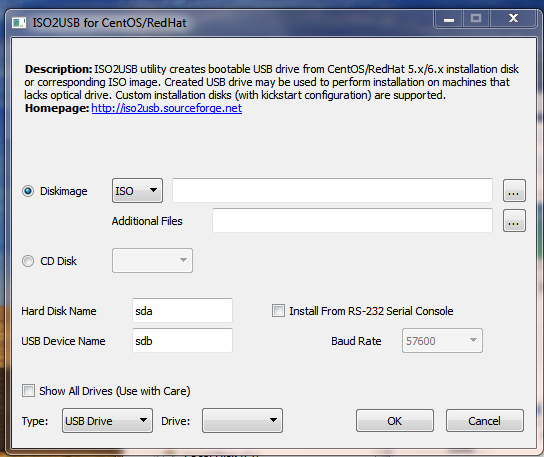
Creating USB Flash Drive. Step #1 is to partition and format your USB flash drive as a FAT32 device. Some flash drives are temperamental about the formatting step. We can’t recommend strongly enough using the HP Formatting Utility to make certain you get a reliable, properly formatted thumb drive! Also be careful that you are, in fact, formatting your thumb drive and not your Windows hard disk!
Step #2, once the device is properly formatted, run ISO2USB. You’ll get a screen that looks like what is shown above. Click on the … button to the right of DiskImage ISO and choose the PIAF2 ISO that you downloaded to your Desktop. Make certain that the destination device shown on the bottom line of the display is your USB flash drive. You do not want to accidentally trash your primary drive!
Here’s the tricky part, and it’s not that tricky any more. You need to know the drive names of the devices on the target machine where you ultimately will be using this thumb drive. Try these commands on your target machine using a Linux LIVE CD if you’re unsure: dmesg | grep logical AND dmesg | grep sectors. For most modern machines with IDE drives, the names will be sda, sdb, etc. For older machines, they may be hda, hdb. You’ll know if it doesn’t work. 🙂
In the ISO2USB setup, we recommend you start with the default settings for the Hard Disk Name (sda) and USB Device Name (sdb). For Foxconn hardware and AMD BIOS machines, you may need to use sdc instead of sdb for the USB Device Name. A few other systems use sdd. In all cases, use sda for the Hard Disk Name. As we noted, you’ll know soon enough if you made the wrong choice. Just recreate the thumb drive using the next letter in the alphabet for the USB Device Name. 😉
Once you’ve double-checked your USB destination drive (HINT: the drive size is quite different), choose OK to begin. When the ISO install completes, don’t forget to Eject your USB flash drive before removing it from the Windows PC!
Using the USB Flash Installer. When using the new flash installer, remember that you need to boot your new machine from the thumb drive. On most newer Atom-based computers, you accomplish this by inserting the USB device, turning the machine on, and then pressing F12 during the boot sequence to choose the boot device. You’ll just have to watch the screen of your new computer to see if some other key is used to pull up the boot selection screen. If all else fails, you can adjust the boot sequence in the BIOS settings to boot first from the USB device. If you change your BIOS boot sequence, just remember to remove the USB device when the initial install of CentOS completes and the PIAF reboot sequence begins. If instead you again see the initial PIAF install screen warning you that your disk is about to be erased, then remove the thumb drive and reboot the machine once again. You’re now ready to continue on with the installation procedure. Just follow this link to the PIAF 20645 tutorial.
Where To Go From Here. If you installed PIAF-Green with Asterisk 11 and FreePBX 2.11 (our recommended platform for production use), then your next step probably should be the Nerd Vittles’ Incredible PBX 11 and Incredible Fax 11 tutorial. It’s a 5-minute addition. And, of course, all 50 Asterisk applications in Incredible PBX are also free.

Getting Your Own PIAF Thumb Drive. Some have asked how to obtain your very own PIAF thumb drive. Well, it’s easy. Just ask when you make a contribution of $50 or more to the Nerd Vittles and PBX in a Flash projects by clicking the PayPal Donate button at the top of this page, and we’ll get one off to you pronto. And, thanks in advance for your support of freeware and open source projects! Happy Thanksgiving!
Originally published: Friday, November 22, 2013
Just Released: AstriCon 2013 Videos. Digium has just released all of the videos from AstriCon 2013 on the new YouTube Asterisk Channel. It’s the best, free VoIP training you’ll find anywhere.


Need help with Asterisk? Visit the PBX in a Flash Forum.
Or Try the New, Free PBX in a Flash Conference Bridge.
whos.amung.us If you’re wondering what your fellow man is reading on Nerd Vittles these days, wonder no more. Visit our new whos.amung.us statistical web site and check out what’s happening. It’s a terrific resource both for us and for you.
Special Thanks to Our Generous Sponsors
FULL DISCLOSURE: ClearlyIP, Skyetel, Vitelity, DigitalOcean, Vultr, VoIP.ms, 3CX, Sangoma, TelecomsXchange and VitalPBX have provided financial support to Nerd Vittles and our open source projects through advertising, referral revenue, and/or merchandise. As an Amazon Associate and Best Buy Affiliate, we also earn from qualifying purchases. We’ve chosen these providers not the other way around. Our decisions are based upon their corporate reputation and the quality of their offerings and pricing. Our recommendations regarding technology are reached without regard to financial compensation except in situations in which comparable products at comparable pricing are available from multiple sources. In this limited case, we support our sponsors because our sponsors support us.
 BOGO Bonaza: Enjoy state-of-the-art VoIP service with a $10 credit and half-price SIP service on up to $500 of Skyetel trunking with free number porting when you fund your Skyetel account. No limits on number of simultaneous calls. Quadruple data center redundancy. $25 monthly minimum spend required. Tutorial and sign up details are here.
BOGO Bonaza: Enjoy state-of-the-art VoIP service with a $10 credit and half-price SIP service on up to $500 of Skyetel trunking with free number porting when you fund your Skyetel account. No limits on number of simultaneous calls. Quadruple data center redundancy. $25 monthly minimum spend required. Tutorial and sign up details are here.
 The lynchpin of Incredible PBX 2020 and beyond is ClearlyIP components which bring management of FreePBX modules and SIP phone integration to a level never before available with any other Asterisk distribution. And now you can configure and reconfigure your new Incredible PBX phones from the convenience of the Incredible PBX GUI.
The lynchpin of Incredible PBX 2020 and beyond is ClearlyIP components which bring management of FreePBX modules and SIP phone integration to a level never before available with any other Asterisk distribution. And now you can configure and reconfigure your new Incredible PBX phones from the convenience of the Incredible PBX GUI.
 VitalPBX is perhaps the fastest-growing PBX offering based upon Asterisk with an installed presence in more than 100 countries worldwide. VitalPBX has generously provided a customized White Label version of Incredible PBX tailored for use with all Incredible PBX and VitalPBX custom applications. Follow this link for a free test drive!
VitalPBX is perhaps the fastest-growing PBX offering based upon Asterisk with an installed presence in more than 100 countries worldwide. VitalPBX has generously provided a customized White Label version of Incredible PBX tailored for use with all Incredible PBX and VitalPBX custom applications. Follow this link for a free test drive!
 Special Thanks to Vitelity. Vitelity is now Voyant Communications and has halted new registrations for the time being. Our special thanks to Vitelity for their unwavering financial support over many years and to the many Nerd Vittles readers who continue to enjoy the benefits of their service offerings. We will keep everyone posted on further developments.
Special Thanks to Vitelity. Vitelity is now Voyant Communications and has halted new registrations for the time being. Our special thanks to Vitelity for their unwavering financial support over many years and to the many Nerd Vittles readers who continue to enjoy the benefits of their service offerings. We will keep everyone posted on further developments.
Some Recent Nerd Vittles Articles of Interest…
The New VoIP Frontier: Meet the iPad Mini with Retina Display

Last week was interesting if for no other reason because Apple released an amazing new product without tooting a single trumpet. In fact, the iPad Mini with Retina display was quietly made available on Apple’s web site in the middle of the night. Most believe that the rationale was that the devices were in such short supply that Apple couldn’t afford the PR nightmare of releasing a new product that very few could buy. Guess what? It’s still available. You have to order on the web. Then you can either pick up the device at your local Apple Store, or have it shipped directly to you… from China. We ordered on Tuesday and received the unit on Friday. What struck us about the new iPad Mini is the striking resemblance to the old iPad Mini. One suspects that Apple is running out of magic bunnies to pull from the hat so we’re getting down to one new gee whiz feature per year. In fairness, the new iPad Mini not only has a Retina display, but also has the new A7 chip with 64-bit architecture. The CPU is up to four times faster while graphics performance saw an 800% improvement without sacrificing battery life. To be completely honest, Apple needed the extra horsepower to drive the retina display, and the battery life has been preserved by increasing its size considerably. Almost half of the inside of an iPad Mini is now nothing but battery. Hop over to iFixIt for all the details.
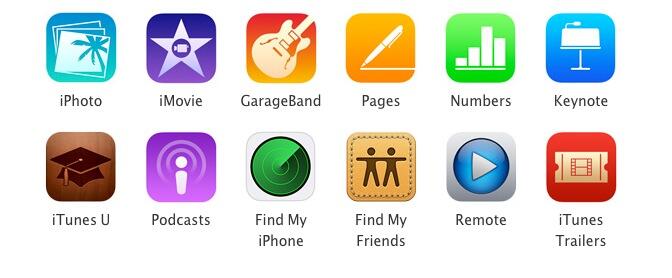
If the new hardware were the only addition, we probably would have had little interest in the new iPad Mini. But we learned a couple of years ago that there’s a dramatic difference in reading on a 7 inch tablet vs. an 8 inch tablet. And, when you add the retina display with 2048-by-1536 resolution and a staggering 326 pixels per inch, the iPad Mini becomes an almost perfect traveling companion for those that do a lot of reading. Apple also bundles an impressive list of business and productivity applications including Siri at no additional cost. For those that work on the Mac platform, the most important enhancement to these apps is that what you see on the Mac desktop using Pages, Numbers, or Keynote is exactly what you’ll see when the document is moved to either the iPad Air or iPad Mini with Retina display. For traveling business folks, that’s a huge improvement!

There have been some equally impressive additions on the communications front for those that enjoy Voice over IP technology. If you’re using PBX in a Flash™ or Asterisk®, we’re pleased to report that the Zoiper IAX client for iOS 7 works flawlessly. Simply set up an IAX extension on your server and enter your credentials in the Zoiper client on your iPad. Screwy as it sounds, Google has released Hangouts on the iOS 7 platform (only) with the added capability to place and receive PSTN phone calls anywhere in the world using a Google Voice PSTN phone number. And calls within the U.S. and Canada are free! Will it disappear? Will Google ever support it on their own Android devices? Who knows? We’ve given up trying to predict what Google will do next, but this addition will probably remain so long as Hangouts continues to be a viable platform. And Google seems to be staking their VoIP fortunes on Hangouts just as Apple has done with FaceTime and Microsoft with Skype. Of course, PSTN calls aren’t possible with FaceTime and, with Skype, PSTN calls are never free. So there is that important difference, and Hangouts fills that niche.
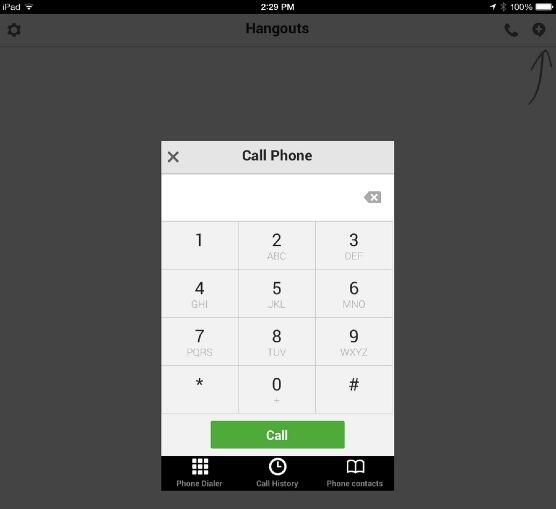
The other major software news is that Google Play Music now is available for iOS 7 as well. In addition to unlimited streaming of almost any music on the planet for $9.95 a month (to a single device at a time), you also can move 20,000 of your favorite songs to the Google Cloud and stream them for free. Apple offers free music alternatives as well including iTunes Radio which now is rolled into the iPad Music app.
There used to be a big reason for buying the cellular addition to the iPads. It made the GPS functionality work. Our Wi-Fi only unit had no problem pinpointing our location with nothing but a WiFi signal. Of course, if you have one of the new Verizon or AT&T bundled data plans, adding an iPad is just $10 a month. That alone would warrant purchase of the unlocked cellular model which now works with all cellular carriers. What a concept!
As you might expect, there are no deals to be had on the iPad Mini with Retina display. But, if you’re looking to buy a new iPad for Christmas, you should probably pay a visit to WalMart or Target on Black Friday. Both retailers are throwing in a $100 gift card with your purchase of the new iPad Air. Nobody other than Apple is yet selling the iPad Mini with Retina display. For another great review, see today’s coverage on The Verge. Enjoy!
Just Released: AstriCon 2013 Videos. Digium has just released all of the videos from AstriCon 2013 on the new YouTube Asterisk Channel.
Originally published: Monday, November 18, 2013

Need help with Asterisk? Visit the PBX in a Flash Forum.
Special Thanks to Our Generous Sponsors
FULL DISCLOSURE: ClearlyIP, Skyetel, Vitelity, DigitalOcean, Vultr, VoIP.ms, 3CX, Sangoma, TelecomsXchange and VitalPBX have provided financial support to Nerd Vittles and our open source projects through advertising, referral revenue, and/or merchandise. As an Amazon Associate and Best Buy Affiliate, we also earn from qualifying purchases. We’ve chosen these providers not the other way around. Our decisions are based upon their corporate reputation and the quality of their offerings and pricing. Our recommendations regarding technology are reached without regard to financial compensation except in situations in which comparable products at comparable pricing are available from multiple sources. In this limited case, we support our sponsors because our sponsors support us.
 BOGO Bonaza: Enjoy state-of-the-art VoIP service with a $10 credit and half-price SIP service on up to $500 of Skyetel trunking with free number porting when you fund your Skyetel account. No limits on number of simultaneous calls. Quadruple data center redundancy. $25 monthly minimum spend required. Tutorial and sign up details are here.
BOGO Bonaza: Enjoy state-of-the-art VoIP service with a $10 credit and half-price SIP service on up to $500 of Skyetel trunking with free number porting when you fund your Skyetel account. No limits on number of simultaneous calls. Quadruple data center redundancy. $25 monthly minimum spend required. Tutorial and sign up details are here.
 The lynchpin of Incredible PBX 2020 and beyond is ClearlyIP components which bring management of FreePBX modules and SIP phone integration to a level never before available with any other Asterisk distribution. And now you can configure and reconfigure your new Incredible PBX phones from the convenience of the Incredible PBX GUI.
The lynchpin of Incredible PBX 2020 and beyond is ClearlyIP components which bring management of FreePBX modules and SIP phone integration to a level never before available with any other Asterisk distribution. And now you can configure and reconfigure your new Incredible PBX phones from the convenience of the Incredible PBX GUI.
 VitalPBX is perhaps the fastest-growing PBX offering based upon Asterisk with an installed presence in more than 100 countries worldwide. VitalPBX has generously provided a customized White Label version of Incredible PBX tailored for use with all Incredible PBX and VitalPBX custom applications. Follow this link for a free test drive!
VitalPBX is perhaps the fastest-growing PBX offering based upon Asterisk with an installed presence in more than 100 countries worldwide. VitalPBX has generously provided a customized White Label version of Incredible PBX tailored for use with all Incredible PBX and VitalPBX custom applications. Follow this link for a free test drive!
 Special Thanks to Vitelity. Vitelity is now Voyant Communications and has halted new registrations for the time being. Our special thanks to Vitelity for their unwavering financial support over many years and to the many Nerd Vittles readers who continue to enjoy the benefits of their service offerings. We will keep everyone posted on further developments.
Special Thanks to Vitelity. Vitelity is now Voyant Communications and has halted new registrations for the time being. Our special thanks to Vitelity for their unwavering financial support over many years and to the many Nerd Vittles readers who continue to enjoy the benefits of their service offerings. We will keep everyone posted on further developments.
Some Recent Nerd Vittles Articles of Interest…
The Definitive VoIP Quick Start Guide: Introducing PBX in a Flash 2.0.6.4.5

What a difference a year makes in the VoIP World! We now have a rock-solid, reliable Asterisk® 11 release and an equally stable FreePBX 2.11 on which to build state-of-the-art VoIP servers. If you’re new to the VoIP community, watch this video before you proceed.
Now let us welcome you to the World of PBX in a Flash™. This is our best release ever whether you’re a total newbie or an experienced Asterisk developer. You can’t really appreciate what goes into an open source product like PBX in a Flash until you try doing it yourself. The sad part is we and the CentOS™ development team are part of a dwindling few non-commercial entities that still are in the open source "business." If you want to actually learn about Asterisk from the ground up using pure source code to customize your VoIP deployment, PBX in a Flash has no competition because your only other option is to roll your own starting with a Linux DVD. So our extra special kudos go to Tom King, who once again has produced a real masterpiece in that it is very simple for a first-time user to deploy and, at the same time, incredibly flexible for the most experienced Asterisk developer. The new PIAF 2.0.6.4.5 ISOs not only provide a choice of Asterisk® and FreePBX® versions to get you started. But now you can build and deploy standalone servers for SugarCRM™, NeoRouter™ VPN, YATE, and OpenFire™ XMPP using the 32-bit and 64-bit PIAF™ ISOs. So let’s get started.
Making a Hardware Selection
We’re going to assume that you need a VoIP telephony solution that will support an office of up to several dozen employees and that you have an Internet connection that will support whatever your simultaneous call volume happens to be. This is above and beyond your normal Internet traffic. To keep it simple, you need 100Kbps of bandwidth in both directions for each call.1 And you need a router/firewall that can prioritize VoIP traffic so that all your employees playing Angry Birds won’t cause degradation in VoIP call quality. Almost any good home router can now provide this functionality. Remember to disable ALG on your router, and it’s smooth sailing.
For computer hardware, you’ll need a dedicated machine. There are many good choices. Unless you have a burning desire to preserve your ties with Ma Bell, we recommend limiting your Ma Bell lines to your main number. Most phone companies can provide a service called multi-channel forwarding that lets multiple inbound calls to your main number be routed to one or more VoIP DIDs much like companies do with 800-number calls. If this works for you, then any good dual-core Atom computer will suffice. You’ll find lots of suggestions in this thread. And the prices generally are in the $200-$400 range. For larger companies and to increase Asterisk’s capacity with beefier hardware, see these stress test results.
If your requirements involve retention of dozens of Ma Bell lines and complex routing of calls to multiple offices, then we would strongly recommend you spend a couple thousand dollars with one of our consultants. They’re the best in the business, and they do this for a living. They can easily save you the cost of their services by guiding you through the hardware selection process. They also have turnkey phone systems using much the same technology as you’ll find in PBX in a Flash. You won’t hurt our feelings. ![]()
Choosing the Right PIAF Platform
We get asked this question about a hundred times a week on the forums so here goes. There are more than two dozen permutations and combinations of CentOS, Asterisk, and FreePBX to choose from when you decide to deploy PBX in a Flash. We always recommend the latest version of CentOS because it tends to be the most stable and also supports the most new hardware. You have a choice to make between a 32-bit OS or 64-bit. Our preference is the 32-bit platform because it is better supported. The performance difference is virtually unnoticeable for most VoIP applications. With Asterisk, we always recommend an LTS release because these have long-term support. That narrows your choices to Asterisk 1.8 or Asterisk 11. At this juncture, we think you’d be crazy to install anything other than Asterisk 11. It’s incredibly reliable and stable, and it will be supported for years to come. It also supports Digium Phones. The bottom line is that Asterisk 11 is the latest and greatest with the best feature set. If we were building a system for a commercial business, it would be our hands-down choice. In the PBX in a Flash world, we have colors for various versions of PBX in a Flash that support different versions of Asterisk. Asterisk 11.6 happens to be the latest PIAF-Green, and we recommend you install it with the latest version of FreePBX as well, 2.11.0.11
Choosing the Right Phones
If there is one thing that will kill any new VoIP deployment, it’s choosing the wrong phones. If you value your career, you’ll let that be an organization-driven decision after carefully reviewing at least 6-12 phones that won’t cause you daily heartburn. You and your budget team can figure out the price points that work in your organization keeping in mind that not everyone needs the same type of telephone. Depending upon your staffing, the issue becomes how many different phone sets are you and your colleagues capable of supporting and maintaining on a long term basis.
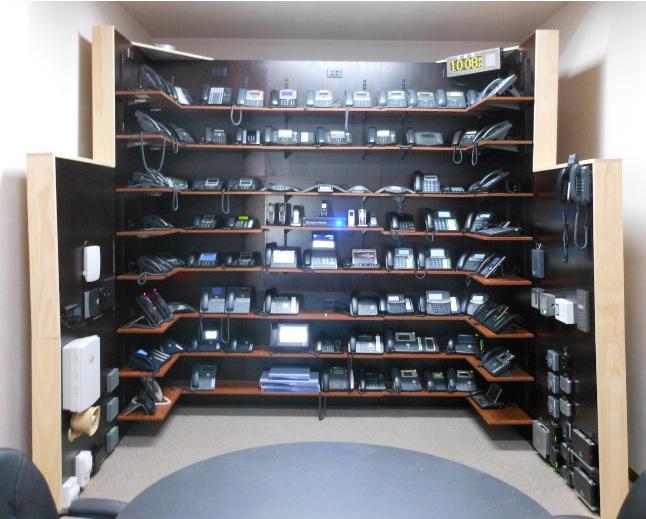
Schmooze Com has released their commercial End Point Manager (EPM) at a price point of $39 per server. They’ve been using the application internally to support their commercial customers for over a year. Suffice it to say, it’s the best money you will ever spend. You can sign up for an account with Schmooze through our commercial support site and purchase the software now. You can review the Admin User Guide here. The beauty of this software is it gives you the flexibility to support literally hundreds of different VoIP phones and devices almost effortlessly. Using a browser, you can configure and reconfigure almost any VoIP phone or device on the market in a matter of minutes. So the question becomes which phones should you show your business associates. That again should be a decision by you and your management and budget teams, but collect some information from end-users first. Choose a half dozen representative users in your company and get each of them to fill out a questionnaire documenting their 10 most frequent daily phone calls and listing each step of how they processed those calls. That will give you a good idea about types and variety of phones you need to consider for different groups of users. Cheaper rarely is better. Keep in mind that phones can last a very long time, even lousy ones. So choose carefully.
The phone brands that we would seriously consider include Cisco, Aastra, Snom, Digium, Mitel, Polycom, Yealink, and Grandstream. Do you need BLF, call parking or multiple line buttons, a hold button, conferencing, speakerphone, HD voice, power over Ethernet support, distinctive ringtones for internal and various types of external calls, Bluetooth, WiFi, web, SMS, or email access, an extra network port for a computer, headset support, customizable buttons (how many?), quick dial keys, custom software, XML provisioning, VPN support? How easy is it to transfer a call? Do you need to mimic key telephones? Also consider color screens, touch screens, busy lamp indicators, extension modules (what capacity?). What do we personally use: Yealink’s T46G is our favorite, and we also have several Digium phones of various types, a couple of Aastra phones, a Grandstream GXP2200, and a collection of Panasonic cordless DECT phones, a fax machine, and Samsung Galaxy Note II connected through an OBi202 with an OBiBT Bluetooth Adapter.
Installing PBX in a Flash
With the office politics out of the way, let’s get to the fun stuff.
- Download PIAF 2.0.6.4.5 ISO from SourceForge
- Burn the ISO to a USB Thumb Drive or a DVD using a Mac or Windows machine
- Boot dedicated server using PIAF Flash Drive or DVD
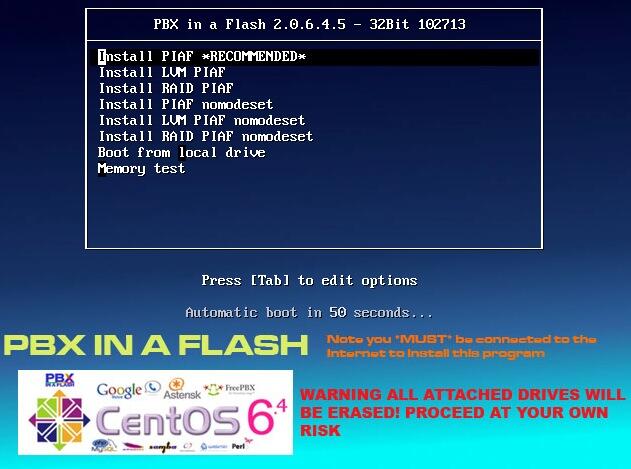
For most deployments, choose the default install by pressing Enter.
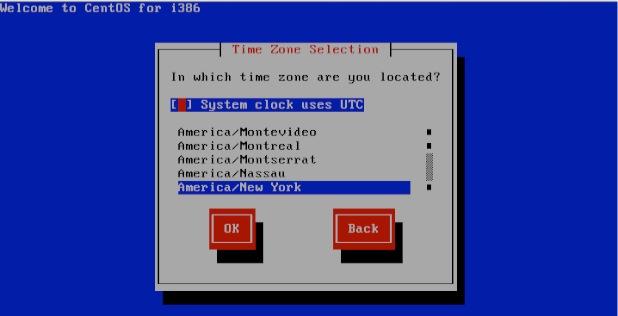
Leave the UTC System Clock option unchecked and pick your Time Zone. Tab to OK and press Enter.
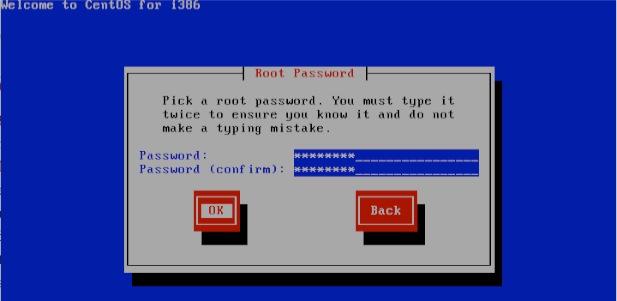
Choose a very secure Root Password. Tab to OK and press Enter. Your server will whir away for 5-10 minutes installing CentOS 6.4. When the reboot begins, remove the DVD or USB thumb drive.
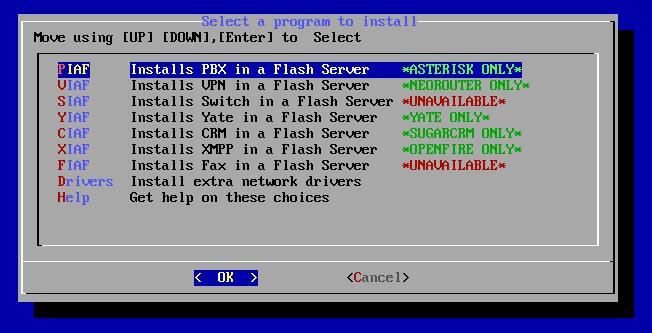
Log into your server as root from either the console or an SSH connection to the IP address displayed on your server. Unless you need to install custom hardware drivers, choose the first option to install PBX in a Flash.
For today, we’re installing PBX in a Flash. So leave it highlighted, tab to OK, and press Enter.
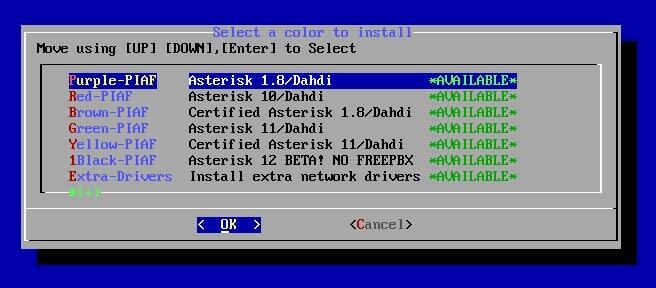
Now pick your PIAF flavor, tab to OK, and press Enter. You’ll note there’s a new color. 🙂

The PIAF Configuration Wizard will load. Press Enter to begin.
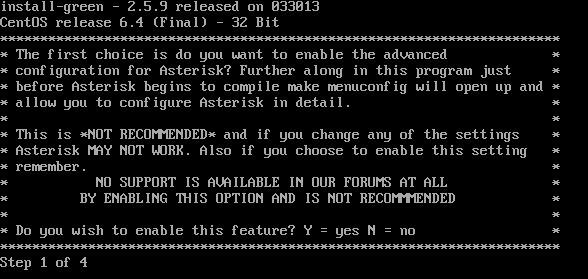
Unlike any other aggregation, PIAF gives you the opportunity to fully configure Asterisk using make menuconfig if you know what you’re doing. For everyone else, type N and then confirm your choice.

Next, you’ll need to choose your Time Zone again for PHP and FreePBX. Don’t worry if yours is missing. A new timezone-setup utility is also to reconfigure this to any worldwide time zone once the install has completed.
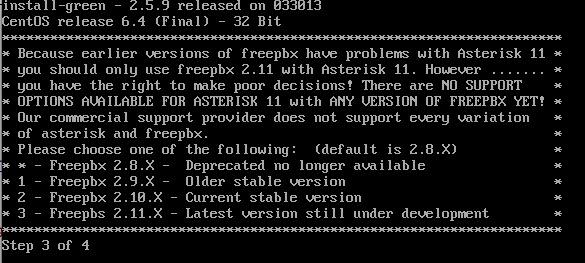
Next, choose your version of FreePBX to install. If you plan to also install Incredible PBX and Incredible Fax:
Incredible PBX 3 requires PIAF-Purple and FreePBX 2.9
Incredible PBX 4 requires PIAF-Purple and FreePBX 2.10 (32-bit only)
Incredible PBX 11 requires PIAF-Green and FreePBX 2.11 (recommended!)
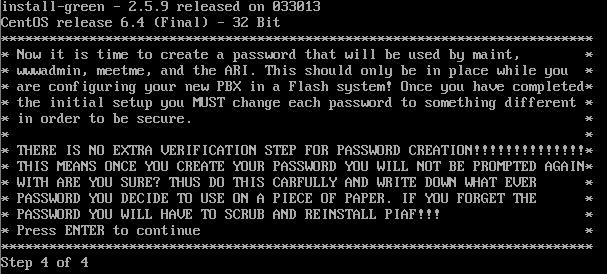
Finally, you need to choose a very secure maint password for access to FreePBX using a browser. You can pick your own, or the installer will generate one for you. Don’t forget it.
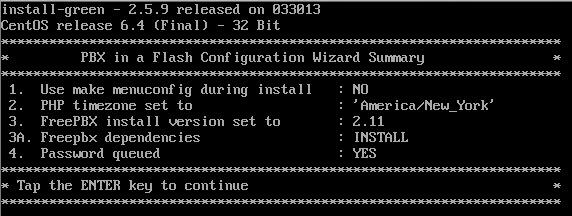
The installer will give you one last chance to make changes. If everything looks correct, press the Enter key and go have lunch. Be sure you have a working Internet connection to your server before you leave. ![]()
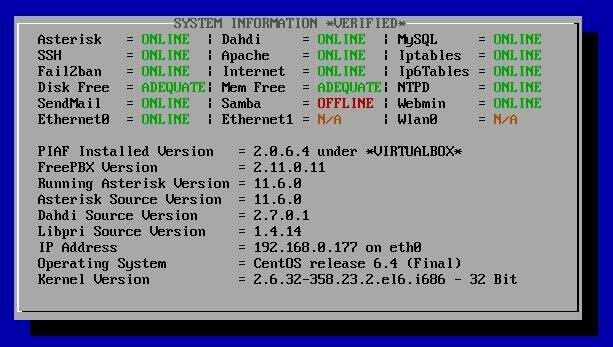
In about 30-60 minutes, your server will reboot. You should be able to log in as root again using your root password. Write down the IP address of your server from the status display (above) and verify that everything installed properly. Note that Samba is disabled by default. If you want to use your server with Windows Networking, run configure-samba once your server is up and running and you’ve logged in.
Configuring PBX in a Flash
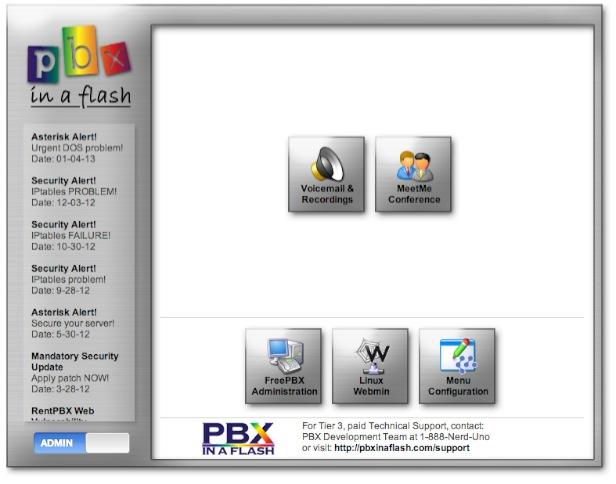
Most PIAF Configuration is accomplished using the FreePBX Web GUI. Point your browser to the IP address shown in the status display above to display your PIAF Home Page. Click on the Users tab. Click FreePBX Administration. When prompted for your username and password, the username is maint. The password will be the FreePBX master password you chose in the Config Module phase of the PBX in a Flash installation procedure above.
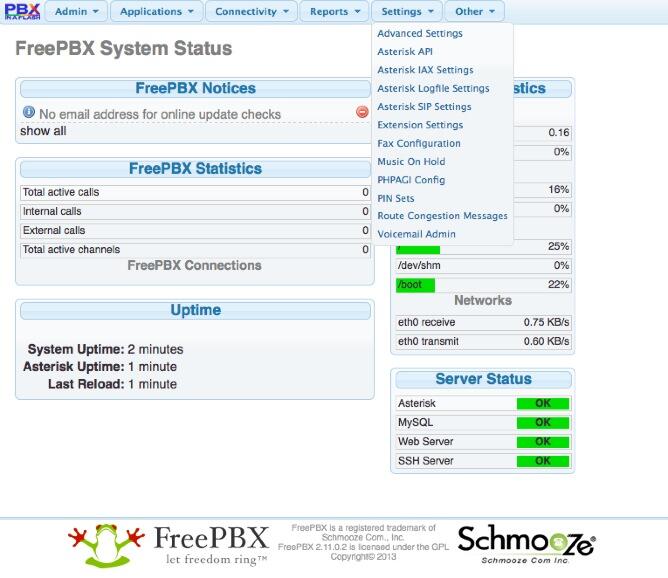
If you’re new to Asterisk and FreePBX, here’s the one paragraph primer on what needs to happen before you can make free calls with Google Voice. You’ll obviously need a free Google Voice account. This gets you a phone number for people to call you and a vehicle to place calls to plain old telephones throughout the U.S. and Canada at no cost. You’ll also need a softphone or SIP phone to actually place and receive calls. YATE makes a free softphone for PCs, Macs, and Linux machines so download your favorite and install it on your desktop. Phones connect to extensions in FreePBX to work with PBX in a Flash. Extensions talk to trunks (like Google Voice) to make and receive calls. FreePBX uses outbound routes to direct outgoing calls from extensions to trunks, and FreePBX uses inbound routes to route incoming calls from trunks to extensions to make your phones ring. In a nutshell, that’s how a PBX works. There are lots of bells and whistles that you can explore down the road. FreePBX now has some of the best documentation in the business. Start here.
To get a minimal system functioning to make and receive calls, here’s the 2-minute drill. You’ll need to set up at least one extension with voicemail, and we’ll configure a free Google Voice account for free calls in the U.S. and Canada. Next, we’ll set up inbound and outbound routes to manage incoming and outgoing calls. Finally, we’ll add a phone with your extension credentials.
A Few Words About Security. PBX in a Flash has been engineered to run on a server sitting safely behind a hardware-based firewall with NO port exposure from the Internet. Leave it that way! It’s your wallet and phone bill that are at stake. If you’re running PBX in a Flash in a hosted environment with no hardware-based firewall, then immediately read and heed our setup instructions for Securing Your VoIP in the Cloud Server. We would encourage you to visit your PIAF Home Page regularly. It’s our primary way of alerting you to security issues which arise. You’ll see them posted (with links) in the RSS Feed shown above. If you prefer, you can subscribe to the PIAF RSS Feed or follow us on Twitter. For late-breaking enhancements, you also should regularly visit the Bug Reporting & Fixes Topic on the PIAF Forum.
Extension Setup. Now let’s set up an extension to get you started. A good rule of thumb for systems with less than 50 extensions is to reserve the IP addresses from 192.x.x.201 to 192.x.x.250 for your phones. Then you can create extension numbers in FreePBX to match those IP addresses. This makes it easy to identify which phone on your system goes with which IP address and makes it easy for end-users to access the phone’s GUI to add bells and whistles. In FreePBX 2.10 or 2.11, to create extension 201 (don’t start with 200), click Applications, Extensions, Generic SIP Device, Submit. Then fill in the following blanks USING VERY SECURE PASSWORDS and leaving the defaults in the other fields for the time being.
User Extension … 201
Display Name … Home
Outbound CID … [your 10-digit phone number if you have one; otherwise, leave blank]
Emergency CID … [your 10-digit phone number for 911 ID if you have one; otherwise, leave blank]Device Options
secret … 1299864Xyz [randomly generated]
dtmfmode … rfc2833
Voicemail Status … Enabled
voicemail password … 14332 [make this unique AND secure!]
email address … yourname@yourdomain.com [if you want voicemail messages emailed to you]
pager email address … yourname@yourdomain.com [if you want to be paged when voicemail messages arrive]
email attachment … yes [if you want the voicemail message included in email]
play CID … yes [if you want the CallerID played when you retrieve message]
play envelope … yes [if you want date/time of the message played before the message]
delete Vmail … yes [if you want the voicemail message deleted after it’s emailed to you]
vm options … callback=from-internal [to enable automatic callbacks by pressing 3,2 after playing a voicemail message]
vm context … default
Write down the passwords. You’ll need them to configure your SIP phone.
Extension Security. We cannot overstress the need to make your extension passwords secure. All the firewalls in the world won’t protect you from malicious phone calls on your nickel if you use your extension number or something like 1234 for your extension password if your SIP or IAX ports happen to be exposed to the Internet.
In addition to making up secure passwords, the latest versions of FreePBX also let you define the IP address or subnet that can access each of your extensions. Use it!!! Once the extensions are created, edit each one and modify the permit field to specify the actual IP address or subnet of each phone on your system. A specific IP address entry should look like this: 192.168.1.142/255.255.255.255. If most of your phones are on a private LAN, you may prefer to use a subnet entry in the permit field like this: 192.168.1.0/255.255.255.0 using your actual subnet.
Adding a Google Voice Trunk. There are lots of trunk providers, and one of the real beauties of having your own PBX is that you don’t have to put all of your eggs in the same basket… unlike the AT&T days. We would encourage you to take advantage of this flexibility. With most providers, you don’t pay anything except when you actually use their service so you have nothing to lose.
For today, we’re going to take advantage of Google’s current offer of free calling in the U.S. and Canada through the end of 2013. You also get a free phone number in your choice of area codes. PBX in a Flash now installs a Google Voice module under FreePBX -> Connectivity that lets you set up your Google Voice account with PBX in a Flash in just a few seconds once you have your credentials.
A Word to the Wise: All good things come to an end… especially those that are free. So plan ahead with some alternate providers that keep your phones working should Google decide to pull the plug or change the terms with Google Voice.
Signing Up for Google Voice. You’ll need a dedicated Google Voice account to support PBX in a Flash. The more obscure the username (with some embedded numbers), the better off you will be. This will keep folks from bombarding you with unsolicited Gtalk chat messages, and who knows what nefarious scheme will be discovered using Google messaging six months from now. So keep this account a secret!
We’ve tested this extensively using an existing Gmail account rather than creating a separate account. Take our word for it. Inbound calling is just not reliable. The reason seems to be that Google always chooses Gmail chat as the inbound call destination if there are multiple registrations from the same IP address. So… set up a dedicated Gmail and Google Voice account2, and use it exclusively with PBX in a Flash. Google Voice no longer is by invitation only. If you’re in the U.S. or have a friend that is, head over to the Google Voice site and register. If you’re living on another continent, see MisterQ’s posting for some tips on getting set up.
You must choose a telephone number (aka DID) for your new account, or Google Voice calling will not work… in either direction. You also have to tie your Google Voice account to at least one working phone number as part of the initial setup process. Your cellphone number will work just fine. Don’t skip this step either. Just enter the provided confirmation code when you tell Google to place the test call to the phone number you entered. Once the number is registered, you can disable it if you’d like in Settings, Voice Setting, Phones. But…
IMPORTANT: Be sure to enable the Google Chat option as one of your phone destinations in Settings, Voice Setting, Phones. That’s the destination we need for PBX in a Flash to function with Google Voice! Otherwise, inbound and/or outbound calls will fail. If you don’t see this option, you may need to call up Gmail and enable Google Chat there first. Then go back to the Google Voice Settings and enable it. Be sure to try one call each way from Google Chat in Gmail. Then disable Google Chat in GMail for this account. Otherwise, it won’t work with PIAF.
While you’re still in Google Voice Settings, click on the Calls tab. Make sure your settings match these:
- Call Screening – OFF
- Call Presentation – OFF
- Caller ID (In) – Display Caller’s Number
- Caller ID (Out) – Don’t Change Anything
- Do Not Disturb – OFF
- Call Options (Enable Recording) – OFF
- Global Spam Filtering – ON
Click Save Changes once you adjust your settings. Under the Voicemail tab, plug in your email address so you get notified of new voicemails. Down the road, receipt of a Google Voice voicemail will be a big hint that something has come unglued on your PBX.
Configuring Google Voice Trunk in FreePBX. All trunk configurations now are managed within FreePBX, including Google Voice. This makes it easy to customize PBX in a Flash to meet your specific needs. Click the Connectivity tab in FreePBX 2.11 and choose Google Voice [Motif]. To Add a new Google Voice account, just fill out the form. NOTE: The form has changed from prior releases of FreePBX. Do NOT check the last box: Send Unanswered to GoogeVoice Voicemail, or you may have problems receiving incoming calls.
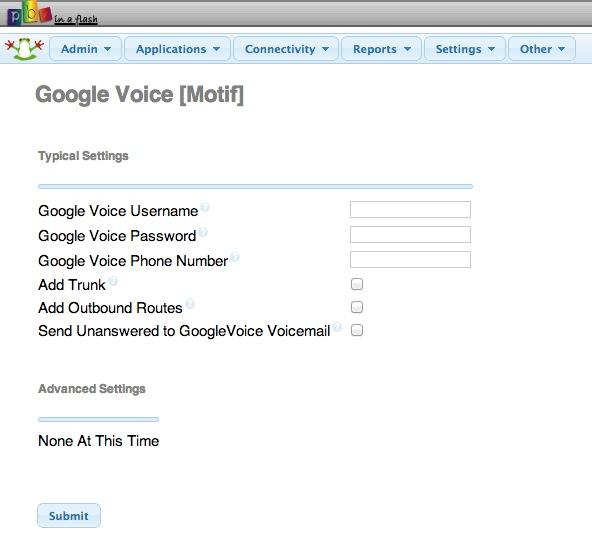
Google Voice Username is your Google Voice account name without @gmail.com. Password is your Google Voice password. NOTE: Don’t use 2-stage password protection in this Google Voice account! Phone Number is your 10-digit Google Voice number. Next, check only the first two boxes: Add Trunk and Add Outbound Routes. Then click Submit Changes and reload FreePBX. Down the road, you can add additional Google Voice numbers by clicking Add GoogleVoice Account option in the right margin and repeating the drill. For Google Apps support, see this post on the PIAF Forum.
Outbound Routes. The idea behind multiple outbound routes is to save money. Some providers are cheaper to some places than others. It also provides redundancy which costs you nothing if you don’t use the backup providers. The Google Voice module actually configures an Outbound Route for 10-digit Google Voice calling as part of the automatic setup. If this meets your requirements, then you can skip this step for today.
Inbound Routes. An Inbound Route tells PBX in a Flash how to route incoming calls. The idea here is that you can have multiple DIDs (phone numbers) that get routed to different extensions or ring groups or departments. For today, we’ll build a simple route that directs your Google Voice calls to extension 201. Choose Connectivity -> Inbound Routes, leave all of the settings at their default values except enter your 10-digit Google Voice number in the DID Number field. Enable CallerID lookups by choosing CallerID Superfecta in the CID Lookup Source pulldown. Then move to the Set Destination section and choose Extensions in the left pull-down and 201 in the extension pull-down. Now click Submit and save your changes. That will assure that incoming Google Voice calls are routed to extension 201.
IMPORTANT: Before Google Voice calling will actually work, you must restart Asterisk from the Linux command line interface. Log into your server as root and issue this command: amportal restart.
Eliminating Audio and DTMF Problems. You can avoid one-way audio on calls and touchtones that don’t work with these simple settings in FreePBX: Settings -> Asterisk SIP Settings. Just plug in your public IP address and your private IP subnet. Then set ULAW as the only Audio Codec.

General Settings. Last, but not least, we need to enter an email address for you so that you are notified when new FreePBX updates are released. In FreePBX 2.11, choose Admin -> Module Admin and click on the Upgrade Notifications shield on the right. Plug in your email address, click Submit, and save your changes. Done!
Setting Up a Desktop Softphone. PBX in a Flash supports all kinds of telephones, but we’ll start with the easy (free) one today. You can move on to "real phones" once you’re smitten with the VoIP bug. For today, you’ll need to download a softphone to your desktop PC or Mac.
The easiest way to get started is to set up a YATE softphone on your Desktop computer. Versions are available at no cost for Macs, PCs, and Linux machines. Just download the appropriate one and install it from this link. Once installed, it’s a simple matter to plug in your extension credentials and start making calls. Run the application and choose Settings -> Accounts and click the New button. Fill in the blanks using the IP address of your server, 201 for your account name, and whatever password you created for the extension. Click OK.

Once you are registered to extension 201, close the Account window. Then click on YATE’s Telephony Tab and place your first call. It’s that easy!

Monitoring Call Progress with Asterisk. That about covers the basics. We’ll leave you with a tip on how to monitor what’s happening with your PBX. There are several good tools within the FreePBX GUI. You’ll find them under the Reports tab. In addition, Asterisk has its own Command Line Interface (CLI) that is accessible from the Linux command prompt. Just execute the following command while logged in as root: asterisk -rvvvvvvvvvv.
What’s Next? We’ve barely scratched the surface of what you can do with PBX in a Flash. Log into your server as root and type help-pbx for a list of simple install scripts that can add almost any function you can imagine. And Incredible PBX 11 and Incredible Fax can be installed in under 2 minutes to provide you almost every Asterisk application on the planet. You can read the complete tutorial here. In addition, Travelin’ Man 3 can be installed as part of Incredible PBX for rock-solid Internet security. If you care about your wallet, add Travelin’ Man to your server!
New App of the Week. We’re pleased to introduce Trunk Failure Email Alerts for Asterisk supporting SIP, IAX2, and Google Motif trunks. Just insert your email address in this little script and run it every hour as a cron job. You’ll get an email alert whenever any of your VoIP trunks fail. Enjoy!

VoIP Experts on Twitter. GetVoip.com has just released their list of The Top 50 VoIP Experts to Follow on Twitter. It’s a great read… but we may be biased. 😉

Originally published: Monday, October 28, 2013
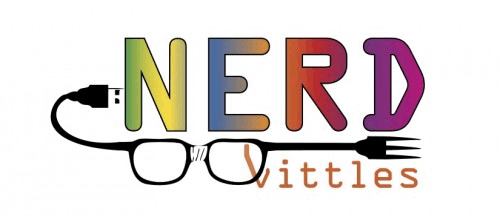
Need help with Asterisk? Visit the PBX in a Flash Forum.
Or Try the New, Free PBX in a Flash Conference Bridge.
whos.amung.us If you’re wondering what your fellow man is reading on Nerd Vittles these days, wonder no more. Visit our new whos.amung.us statistical web site and check out what’s happening. It’s a terrific resource both for us and for you.
Special Thanks to Our Generous Sponsors
FULL DISCLOSURE: ClearlyIP, Skyetel, Vitelity, DigitalOcean, Vultr, VoIP.ms, 3CX, Sangoma, TelecomsXchange and VitalPBX have provided financial support to Nerd Vittles and our open source projects through advertising, referral revenue, and/or merchandise. As an Amazon Associate and Best Buy Affiliate, we also earn from qualifying purchases. We’ve chosen these providers not the other way around. Our decisions are based upon their corporate reputation and the quality of their offerings and pricing. Our recommendations regarding technology are reached without regard to financial compensation except in situations in which comparable products at comparable pricing are available from multiple sources. In this limited case, we support our sponsors because our sponsors support us.
 BOGO Bonaza: Enjoy state-of-the-art VoIP service with a $10 credit and half-price SIP service on up to $500 of Skyetel trunking with free number porting when you fund your Skyetel account. No limits on number of simultaneous calls. Quadruple data center redundancy. $25 monthly minimum spend required. Tutorial and sign up details are here.
BOGO Bonaza: Enjoy state-of-the-art VoIP service with a $10 credit and half-price SIP service on up to $500 of Skyetel trunking with free number porting when you fund your Skyetel account. No limits on number of simultaneous calls. Quadruple data center redundancy. $25 monthly minimum spend required. Tutorial and sign up details are here.
 The lynchpin of Incredible PBX 2020 and beyond is ClearlyIP components which bring management of FreePBX modules and SIP phone integration to a level never before available with any other Asterisk distribution. And now you can configure and reconfigure your new Incredible PBX phones from the convenience of the Incredible PBX GUI.
The lynchpin of Incredible PBX 2020 and beyond is ClearlyIP components which bring management of FreePBX modules and SIP phone integration to a level never before available with any other Asterisk distribution. And now you can configure and reconfigure your new Incredible PBX phones from the convenience of the Incredible PBX GUI.
 VitalPBX is perhaps the fastest-growing PBX offering based upon Asterisk with an installed presence in more than 100 countries worldwide. VitalPBX has generously provided a customized White Label version of Incredible PBX tailored for use with all Incredible PBX and VitalPBX custom applications. Follow this link for a free test drive!
VitalPBX is perhaps the fastest-growing PBX offering based upon Asterisk with an installed presence in more than 100 countries worldwide. VitalPBX has generously provided a customized White Label version of Incredible PBX tailored for use with all Incredible PBX and VitalPBX custom applications. Follow this link for a free test drive!
 Special Thanks to Vitelity. Vitelity is now Voyant Communications and has halted new registrations for the time being. Our special thanks to Vitelity for their unwavering financial support over many years and to the many Nerd Vittles readers who continue to enjoy the benefits of their service offerings. We will keep everyone posted on further developments.
Special Thanks to Vitelity. Vitelity is now Voyant Communications and has halted new registrations for the time being. Our special thanks to Vitelity for their unwavering financial support over many years and to the many Nerd Vittles readers who continue to enjoy the benefits of their service offerings. We will keep everyone posted on further developments.
Some Recent Nerd Vittles Articles of Interest…
AstriCon 10: WOW! What a Coming Out Party for Asterisk 12!

It was the tenth anniversary of AstriCon in Atlanta this week with an SRO crowd, and what a week it was. Comparing Asterisk® 12 to Asterisk 11 and previous iterations would be much like comparing Windows 8 to Windows 3.1. Facelift doesn’t begin to describe the metamorphosis. There’s a brand new (robust) SIP implementation featuring PJSIP, and a new restful interface known as ARI that lets you get at all of the Asterisk internals with a simple web command. You can transfer calls, play sound files, set up conferences and move participants with the click of a button. Here’s the complete slideshow on Asterisk 12. That’s just the tip of iceberg. Features still are being added almost weekly. Unlike previous releases, there’s no feature freeze in Asterisk 12 so long as the additions are germane to the new functionality already incorporated into Asterisk 12. See the Wiki link for details. And the work under the hood really shines. Here’s another shocker. There’s actually documentation. In fact, you can no longer add code to the project without also providing documentation for your code. Yes, this is truly a WOW moment! Think of it more as the Second Coming of Asterisk. Most importantly, the alpha release was relatively stable! And now there’s a beta.

We were so excited by our preliminary look at Asterisk 12-alpha and the new PIAF-Black (we’re running out of colors) preview that we actually set up our Incredible PBX IVR with news, weather, stocks, reminders, and conferencing in our car for the 5-hour trip to Atlanta. Speech to text works. Text to speech works. In fact, with the exception of CDRs, everything worked with the existing FreePBX® 2.11 dialplan code. The CDR transformation will get sorted out in coming weeks/months with the introduction of FreePBX 2.12. Back to our story, with the help of Verizon Wireless 4G LTE tethering, close to a hundred people called into the demo IVR to try things out for themselves. No crashes, no stuttering, high quality VoIP calls. In short, just pure Allison IVR goodness. See if you can find her in the snapshot of your favorite hams.
Monday and Tuesday of AstriCon are primarily devoted to future development goals and objectives. Known as AstriDevCon, the forum is by invitation only to about 50 developers. We were fortunate to be included this year, but the work of the group is no secret. You can review exactly what was said and where we’re headed in this Wiki posting of the meeting. The good news is there will be more meat on the bones of Asterisk 12. And our security recommendations regarding incorporation of Fail2Ban-like functionality directly into Asterisk made the list. This means attacks and vulnerabilities can be identified in real time rather than delaying a response until Fail2Ban has had time to scan your logs for nefarious activity. We also were heartened to see almost a third of AstriCon presentations devoted to beefing up security on Asterisk systems. We’ll have more to say about those discussions as well as some recommendations in coming weeks.
WebRTC also was a big hit at AstriCon 10. This provides the functionality to make and receive phone calls to Asterisk-based systems using nothing more than a web browser. A WebRTC implementation for FreePBX-based systems including PBX in a Flash is just around the corner. Some of you may recall that we released a WebRTC appliance based upon PBX in a Flash last winter. It will run on any Windows, Mac, or Linux desktop so read the tutorial and download away for a quick preview of what’s coming.
We were especially pleased to review Steve Murphy’s new SayScript proposal for Asterisk 13. In a nutshell, this would transform all "say" commands with prerecorded sound files into pluggable modules with translation to any language on the fly. "Language packs" would be developed that include script files, prompts, and SayScript logic to handle almost any speech chore in Asterisk. Think of it as Text-to-Speech on Steroids. Here’s a complete copy of Steve’s presentation in PDF format if you’d like more details.

Last but not least, Schmooze introduced a new fault-tolerant, high availability commercial module for FreePBX that brings complete redundancy to the Asterisk platform for the first time. Until October 15, you can purchase the two-node system for half-price, just $1,500. Be sure to let them know your friends at Nerd Vittles referred you so that we can keep the lights on for another year. And keep us posted during your deployment.
Originally published: Friday, October 11, 2013

Need help with Asterisk? Visit the PBX in a Flash Forum.
Special Thanks to Our Generous Sponsors
FULL DISCLOSURE: ClearlyIP, Skyetel, Vitelity, DigitalOcean, Vultr, VoIP.ms, 3CX, Sangoma, TelecomsXchange and VitalPBX have provided financial support to Nerd Vittles and our open source projects through advertising, referral revenue, and/or merchandise. As an Amazon Associate and Best Buy Affiliate, we also earn from qualifying purchases. We’ve chosen these providers not the other way around. Our decisions are based upon their corporate reputation and the quality of their offerings and pricing. Our recommendations regarding technology are reached without regard to financial compensation except in situations in which comparable products at comparable pricing are available from multiple sources. In this limited case, we support our sponsors because our sponsors support us.
 BOGO Bonaza: Enjoy state-of-the-art VoIP service with a $10 credit and half-price SIP service on up to $500 of Skyetel trunking with free number porting when you fund your Skyetel account. No limits on number of simultaneous calls. Quadruple data center redundancy. $25 monthly minimum spend required. Tutorial and sign up details are here.
BOGO Bonaza: Enjoy state-of-the-art VoIP service with a $10 credit and half-price SIP service on up to $500 of Skyetel trunking with free number porting when you fund your Skyetel account. No limits on number of simultaneous calls. Quadruple data center redundancy. $25 monthly minimum spend required. Tutorial and sign up details are here.
 The lynchpin of Incredible PBX 2020 and beyond is ClearlyIP components which bring management of FreePBX modules and SIP phone integration to a level never before available with any other Asterisk distribution. And now you can configure and reconfigure your new Incredible PBX phones from the convenience of the Incredible PBX GUI.
The lynchpin of Incredible PBX 2020 and beyond is ClearlyIP components which bring management of FreePBX modules and SIP phone integration to a level never before available with any other Asterisk distribution. And now you can configure and reconfigure your new Incredible PBX phones from the convenience of the Incredible PBX GUI.
 VitalPBX is perhaps the fastest-growing PBX offering based upon Asterisk with an installed presence in more than 100 countries worldwide. VitalPBX has generously provided a customized White Label version of Incredible PBX tailored for use with all Incredible PBX and VitalPBX custom applications. Follow this link for a free test drive!
VitalPBX is perhaps the fastest-growing PBX offering based upon Asterisk with an installed presence in more than 100 countries worldwide. VitalPBX has generously provided a customized White Label version of Incredible PBX tailored for use with all Incredible PBX and VitalPBX custom applications. Follow this link for a free test drive!
 Special Thanks to Vitelity. Vitelity is now Voyant Communications and has halted new registrations for the time being. Our special thanks to Vitelity for their unwavering financial support over many years and to the many Nerd Vittles readers who continue to enjoy the benefits of their service offerings. We will keep everyone posted on further developments.
Special Thanks to Vitelity. Vitelity is now Voyant Communications and has halted new registrations for the time being. Our special thanks to Vitelity for their unwavering financial support over many years and to the many Nerd Vittles readers who continue to enjoy the benefits of their service offerings. We will keep everyone posted on further developments.
Some Recent Nerd Vittles Articles of Interest…
Finally a 100% Portable PBX: Introducing GoIP, a SIP-GSM Gateway for Asterisk
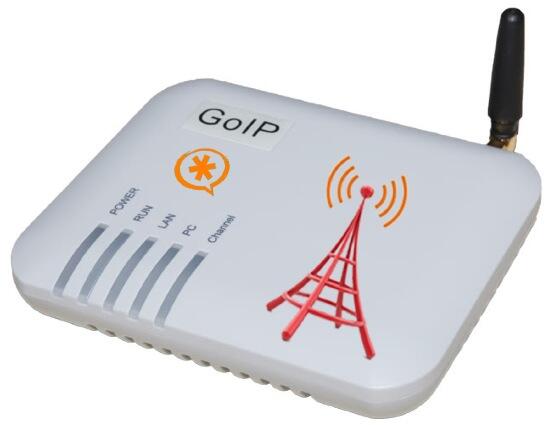
How far we have come! The original Asterisk® claim to fame was its ability to interface with proprietary phone systems and legacy telephony hardware, the glue that literally kept companies stuck to their overpriced PBXs. And, just as wired phone systems began to lose their edge, along came the Bell Sisters to introduce cellular communications with billing that began when the phone started ringing and an end to toll-free calling and extra fees for text messaging on top of exorbitantly priced data service. The piece that traditionally has been missing from Asterisk deployments has been interconnectivity with cellular data services. Well, that was then, and this is now. Meet the GoIP GSM Gateway in one, four, eight, and 16-channel flavors to meet your every need. Our focus today will be the one-channel GoIP device, but the larger units work almost identically so, once you’ve mastered the device, it’s not rocket science to move to the 4-channel or 8-channel device (or even larger) if the extra GSM ports better meet your office’s requirements.1
Let’s begin with the basics. What does it do? What does it cost? Why do I need it? How steep is the learning curve?
What Does It Do? In a nutshell, GoIP is a SIP-talkin’ GSM gateway that sits on the same network as your Asterisk server. Once you configure a trunk and a few special Asterisk settings to support SMS messaging, you’ll have another full-featured provider for your PBX, only this one happens to be GSM cellular-based. The good news is GoIP brings to your PBX most of the same feature set that is available using your favorite GSM cellphone except now every extension on your PBX in a Flash™ server can share the cellular connection both for calls and messaging. That means inbound and outbound cell calls as well as inbound and outbound SMS messaging for every extension on your PBX.
With today’s Nerd Vittles additions, here’s the new feature set using a GoIP device from any extension on your PBX:
- Make outbound calls through the GoIP cellular trunk from any PBX extension
- Receive incoming cellular calls and redirect them to any number on your PBX
- Dictate text by phone and deliver SMS messages to any SMS-capable device
- Use a browser to create and deliver outbound SMS messages to any SMS device
- Receive incoming SMS messages and forward the messages to any email address
- Receive incoming SMS messages and forward the messages to any SMS number
- Send an SMS message with a password and receive a callback with DISA dialtone
What Does It Cost? As much as we love Amazon for its referral revenue support of our blog and open source projects, we couldn’t find a single-channel GoIP offering at a reasonable price. The Amazon links provided above for the larger units are competitive (about $100 per port). For the single-channel model, eBay® is your friend. You’ll find multiple providers in the $150 price range. All of the units we’ve found ship from China. We used this provider who got the GoIP device to us exactly 14 days after we ordered it. Ours shipped with the latest firmware, but firmware updates are available here. AliExpress also sells the devices for about the same price. We’ve had good luck with them in the past.
The other expense with the GoIP devices is cellular service. For each channel, you’ll need a GSM SIM card just like what your GSM, AT&T, or T-Mobile cell phone uses. The good news is there are lots of other choices now. See WalMart for some options. Another option for low frequency use would be T-Mobile’s pay-by-the day plans. The $1 (unlimited SMS messaging) or $2/day (unlimited calls and unlimited SMS messaging) plans are almost perfect since you don’t need data. Just be sure to choose a GSM carrier, AT&T or T-Mobile in the U.S. market. Both are supported by StraightTalk. Our favorite remains the (almost) unlimited calling, text, and data $45 plan from StraightTalk. With their AT&T-compatible SIM (don’t buy it in a StraightTalk-locked phone!), it’s a simple matter of moving the SIM card from your cellphone to the GoIP’s GSM slot (connectors facing down). The GoIP unit can spoof an IMEI for picky providers.

Why Do I Need It? The two major advantages of adding a cellular trunk to your PBX are redundancy and portability. Except in the Hurricane Katrina situation, chances are that your Internet service provider and your cellular provider won’t both be dead in the water2 at the same time. The good news is that even with a hurricane, you can pack up your PBX in a Flash server or Raspberry Pi together with your GoIP device and move to higher ground. As fast as you can say "George Bush is a compassionate conservative," you’ll be back in business.
And then there are the mobile users such as construction site workers, mobile firefighters deployed to a site far from home and other first responders, or even the nomads that manage conventions in a different town every week. Think AstriCon! Rather than relying on crappy hotel WiFi service or paying an arm and a leg for installation of cable or DSL Internet service which often isn’t available anyway, now you have the flexibility to deploy a full-featured PBX at almost any temporary site with nothing more than a $30 Wi-Fi firewall/router, a PBX in a Flash Server or Raspberry Pi, and a GSM SIP trunk courtesy of GoIP. The only other ingredient you need is a little electricity. That could be a wall outlet, or a generator, or an inexpensive AC inverter for your vehicle. Did we mention it’ll work identically on the next site without spending an extra nickel. Hardware cost for the Mobile Communications Center (as shown below): about $250.
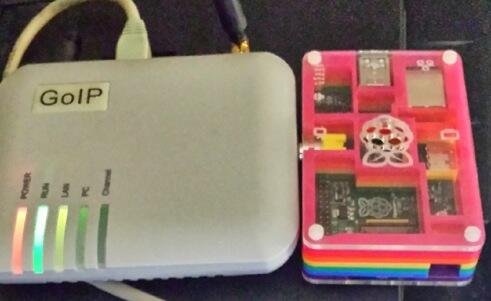
Last but not least are all of the organizations that could benefit from an SMS-based emergency messaging service. A dollar a day is a small price to pay to deploy a service that can alert the public, employees, or parents and students of emergency situations. Before you read about the next mass shooting or midnight tornado, give it some thought. We’ve already introduced SMS Blaster to make the job easy. Or you can roll your own by building a simple text file in /tmp/callees.txt with a 10-digit3 callee’s phone number on each line. Then add the following snippet to your Asterisk dialplan code and put your emergency message in line 2. You’ve just replaced a $100 a month message blasting service with a totally portable, self-managed solution. And you’ll recover your hardware costs in less than three months.
[goip-sms-blaster]
exten => s,1,Answer
exten => s,n,Set(SMSMSG="Here is where your emergency message goes.")
exten => s,n,ReadFile(callees=/tmp/callees.txt)
exten => s,n,Set(callees=${URIENCODE(${callees})})
exten => s,n,Set(callees=${REPLACE(callees,%0A,-)})
exten => s,n,Set(SMSNUM=${callees:0:10})
exten => s,n,While($[${LEN(${SMSNUM})}>9])
exten => s,n,NoOp(Here's where we send SMS message to: ${SMSNUM})
exten => s,n,Set(SMSOUT=${SMSNUM}%0A${SMSMSG})
exten => s,n,Set(SMSOUTRAW=${URIDECODE(${SMSOUT})})
exten => s,n,Set(MESSAGE(body)=${SMSOUTRAW})
exten => s,n,MessageSend(sip:goip_1)
exten => s,n,Set(callees=${callees:13})
exten => s,n,Set(SMSNUM=${callees:0:10})
exten => s,n,Set(SMSNUM=${REPLACE(SMSNUM,-,0)})
exten => s,n,EndWhile()
exten => s,n,Hangup()
How Steep Is the Learning Curve? Lucky for you, you’re not going to have to worry about the learning curve. After all, that’s why you come to Nerd Vittles, isn’t it? We’ve spent the better part of a week getting the GoIP to sit up and bark. If you’re a slow typist, it might take you 10 minutes to get everything set up and functional once you have your GoIP device and SIM card in hand. When we’re finished, you’ll have an easy way to make and receive calls through your GoIP device using any extension on your PBX. And you’ll have a simple utility to send and receive SMS messages. In fact, you’ll be able to dictate your SMS messages from any phone connected to your PBX and send them out to any number supported by SMS including the millions of Google Voice numbers. Last but not least, we’ll provide a utility to send password-protected SMS messages to GoIP and receive a return call with DISA dial tone to make outbound calls using any available trunks on your PBX.
A Word About Security. We’re a little paranoid when it comes to security so bear with us. Without impugning anyone’s integrity, suffice it to say this device is manufactured in China. Although the device reportedly runs Linux, none of its other firmware is open source, at least not that we could find. There also are three back doors into the system which can be triggered by SMS commands to the device itself. These are well documented in the GoIP User’s Manual. Whether there are other backdoors or whether the device "phones home" are questions we have neither the time nor the money to explore. Unless you do, you are well advised to treat the device in the same way you would treat a new employee on their first day at work. Don’t put the device on a private LAN in which other computers or devices on the LAN are not protected. Don’t use a SIM card with an automatic renewal feature or with authority to post charges against your credit or debit card. Change your Admin password to the device immediately. Don’t use a password you use elsewhere! Anyone can reset the device to factory defaults by knowing the default credentials and sending RESET admin in an SMS message to the device. We love the device, but be careful.
Initial Setup of the GoIP Device
To begin, you’ll need cellphone coverage in the place where you intend to connect your GoIP device. Verify this while the SIM card you plan to use is still installed in a working cellphone. Make a call and send an SMS message to verify that the site is appropriate. Next, verify that you have a place to connect your GoIP device to your LAN in the same location. Both of these are important first steps, or you’ll be wasting your time continuing on. Once the connectivity issues are out of the way, turn off your cell phone, remove the GSM SIM card, and insert it into the GoIP device with the connectors pointing downward. You should hear a click when the SIM card is properly seated. Now connect the device behind a hardware-based firewall/router that provides DHCP service. Plug an Ethernet cable into the LAN port of the GoIP device and connect it to your network. Finally, using the power adapter provided, apply power to the device. Watch the blinking lights. While booting the RUN light will flash on and off every 100 milliseconds. Once the RUN and CHANNEL lights flash GREEN once per second, you’re in business. Now use another cellphone to send a text message with the word INFO to the phone number associated with the SIM card you plugged into the GoIP Device. You should receive a return message telling you the DHCP LAN address associated with the GoIP CHANNEL port where you plugged in the SIM card. Write it down! We’re not going to use the PC port so you can ignore its IP address for now.
Asterisk Prerequisites for Today’s GoIP Project
We’ll be using PIAF-Green with Asterisk 11 and FreePBX 2.11 today so you’ll have to read between the lines if you’re using a prehistoric release or a non-FreePBX system. We’re also assuming you’ve installed Incredible PBX™ 11 which provides the necessary components to get Google’s text-to-speech and speech-to-text features working. If you’d prefer to roll your own, then start by installing Lefteris Zafiris’ GoogleTTS and Speech Recognition components for Asterisk. For PBX in a Flash users that aren’t using Incredible PBX, you can follow this tutorial to install all of the necessary components in one click.
Initial Setup of FreePBX for the GoIP Device
We’ve found that it’s easier to configure the FreePBX® side to support the GoIP, and then configure the GoIP unit. There are seven simple steps. If you don’t want SMS DISA callback support in your setup, skip the last two steps.
- Add GoIP SIP Trunk
- Add Custom SIP Settings
- Add GoIP Outbound Route
- Add GoIP Custom Destination
- Add GoIP Misc Application
- Add GoIP DISA Context
- Add GoIP DISA Misc Application
1. Start by adding a new SIP Trunk to support the GoIP device. Be sure to match the device names we’ve shown exactly, or nothing will work. Our special thanks to samyantoun for his initial work on this. Replace 192.168.0.107 with the IP address of your GoIP. Replace 77 with whatever dialing prefix you want to use to make calls through the GoIP trunk. And add the phone number associated with your GoIP in the Outbound CallerID field. If you’re using the GoIP device behind a hardware-based firewall with no Internet port exposure, then you can leave password as the secret. Otherwise, you would want something very secure!4
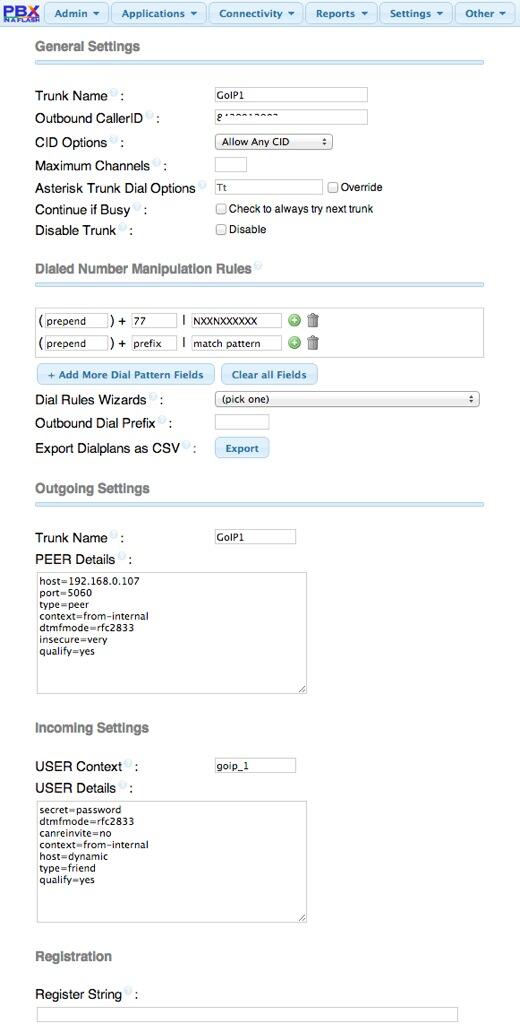
2. Add a couple of custom SIP entries at the bottom of Asterisk SIP Settings to support SMS messaging with Asterisk. Set accept_outofcall_messages=yes and outofcall_message_context=sms_message. Then Submit Changes.

3. Add an Outbound Route to make calls using your GoIP device using the dial prefix you chose for the trunk:
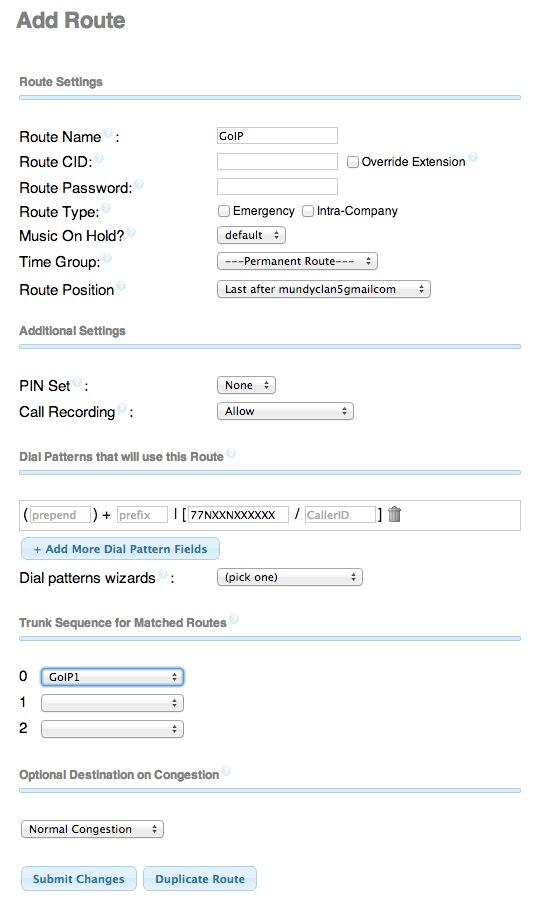
4. Next we need to add a FreePBX Custom Destination to support the Nerd Vittles speech-to-text module which we’ll be using to dictate and send SMS messages using any telephone on your PBX. Under Admin -> Custom Destination, add an entry that looks like this:
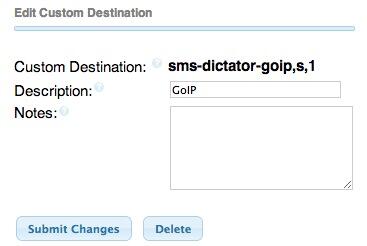
5. Then we need to associate an extension number with the custom destination we just added. We’ve chosen 4647 which spells GoIP. Choose Applications -> Misc Application and enter the following:
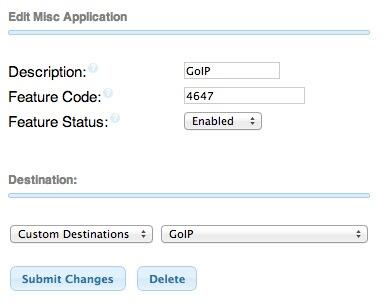
6. DISA is an Asterisk function that lets someone call into your PBX and obtain dial tone to place an outbound call using the available trunks on your PBX. In the case of the GoIP device, this gets a little fancier. We’ll actually be sending an SMS message with a custom password to the GoIP device, and it will in turn call the SMS sender’s number and provide DISA dialtone after the user enters a special DISA PIN. Make the PIN and password very secure. We’ll get to the password in a minute. On the FreePBX side, add a DISA context in FreePBX under Applications -> DISA that looks something like the following with a secure PIN (not the one in the example):
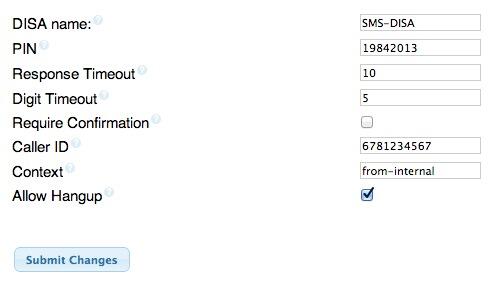
7. In order to use DISA with GoIP, we’ll need an extension associated with the DISA function. We add this number using FreePBX Misc Application. You can use any available extension number you like. Just remember what you chose when we configure the GoIP side to support SMS DISA access. Here’s what we use:
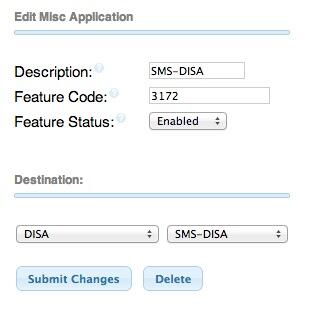
Configuration of the GoIP Device
All of the GoIP device configuration is handled using a browser pointed to the internal IP address of the GoIP. If you haven’t already done so, send an SMS message with the word INFO to the phone number associated with your GoIP device. You will get a return message with the private IP address of the unit. Using a browser, point it to the IP address and login with username admin and password admin. It’s probably a good idea to reset your unit to factory defaults before beginning the setup just to make sure you’re starting with a clean slate. Send an SMS message to the device with the words RESET admin to initialize the hardware.
As we’ve mentioned, sending the admin password to the device with the RESET keyword forces a total reset of the device so you obviously want to change this admin password immediately unless you want to risk a total stranger sending a reset command to your device. Do it now under Tools -> Change Password -> Administration Level. It’s probably a good idea to change the other passwords as well.
Next, click Configurations. This is the screen on which you set everything. The Preference pane has the country-specific settings for both the network and your cellphone carrier so set them carefully. The IMEI will default to the actual IMEI of your unit. If your cellphone carrier requires registration of a specific IMEI before your SIM card will work, then you can spoof the IMEI using the IMEI of the cell phone that was previously used with this SIM card. For the East Coast of the United States, our setup looks like this:
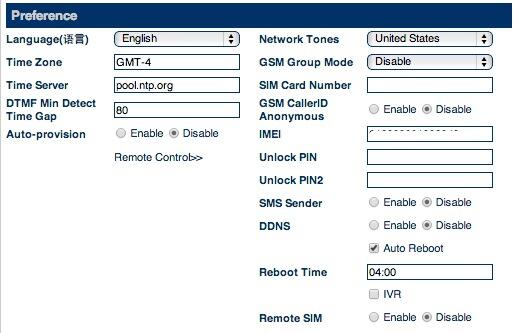
If you’re using DHCP for the GoIP, the Network Configuration pane shouldn’t require any changes. We do recommend that you lock the DHCP address to the GoIP in your router so that it doesn’t inadvertently change down the road. You will note that a PPTP VPN tunnel for the device is supported although we haven’t yet played with it.
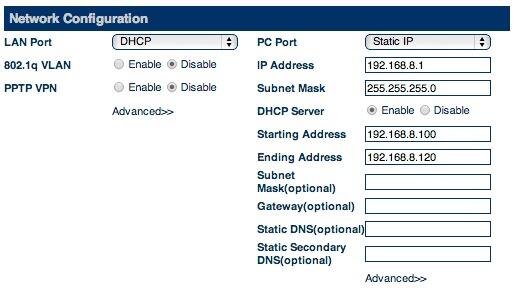
The Call Settings pane has all of your SIP settings for the GoIP. These have got to be right or nothing will work. Our setup (that works) is shown below. Start by clicking on each of the Settings and Preferences links to open up the sub-menus. Both 192.168.0.180 entries should be replaced with the IP address of your Asterisk server. The Phone Number and Authentication ID both need to be goip_1 as shown. The password is password unless you changed your secret in the FreePBX trunk setup. DTMF Signaling should be changed to Outband and DTMF Type should be RFC2833. Ours still doesn’t work reliably, but that may be the lousy cellphone signal in our office. We recommend ULAW and ALAW exclusively for the Audio Codecs. You don’t want the overhead of codec translation particularly if you’re using a Raspberry Pi. On a normal server, G.729 would obviously reduce the bandwidth of GoIP voice calls. Get it working first and then experiment! The RTP port range should be 10000-20000 to match your Asterisk default setup.
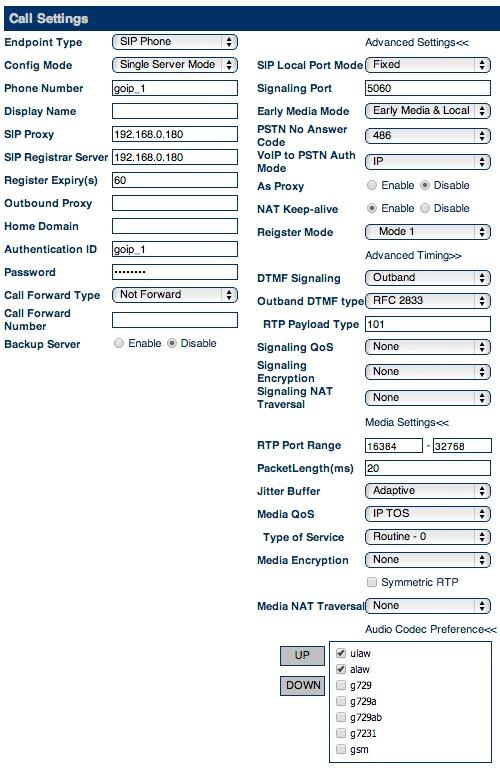
The Call Divert pane is where we configure all of the Nerd Vittles magic. Forward Number(PSTN To VoIP) should be the number on your PBX to which you want inbound GoIP calls forwarded when someone calls the cellphone number associated with your GoIP device. This could be an extension, ring group, IVR, or even the DISA number we set up above. Just be sure you have a verrrrrry secure DISA PIN if you go this route! It’s your phone bill. The SMS Mode must be changed to Relay, and SMS Forward SIP Number must be s to work with the Nerd Vittles apps.
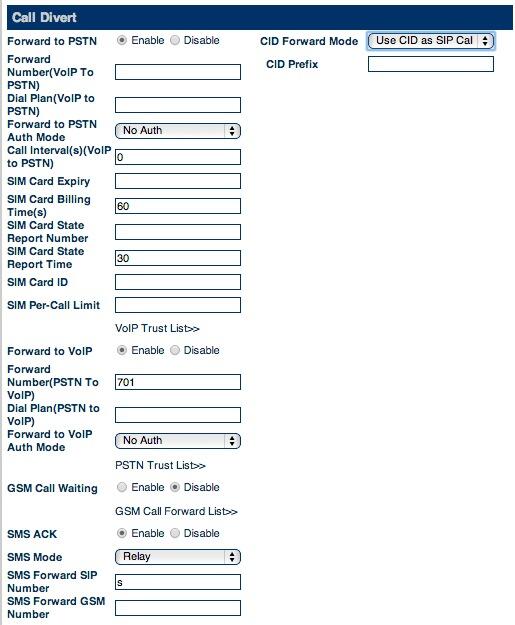
Once you have all of your settings entered, click the Save Settings link under Configurations. The unit will reload its SIP setup. It usually takes about 30 seconds. We recommend you now test the setup to make sure you can make a call to the GoIP number and have it forwarded to an extension on your Asterisk server. Then use an extension on your PBX to place an outbound call using the GoIP dial prefix you assigned above. If either call fails, check your settings for typos in both the FreePBX and GoIP configurations.
Adding the Nerd Vittles Apps to Support the GoIP Device
Now for the fun stuff. We’ve built a little shell script that sets up all of the Nerd Vittles applications we outlined above. It’s licensed as GPL2 code so you are more than welcome to make any changes or additions which you believe would be useful. We hope you’ll share them with the rest of us. The script puts everything in the proper place on Incredible PBX systems to support SMS messaging with Asterisk. You’ll be prompted for the following information:
- Email address to which to forward incoming SMS messages
- SMS number to which to forward incoming SMS messages
- Very secure password to trigger PBX callbacks
- Extension number to ring on callbacks
1. When incoming SMS messages are received by the GoIP unit, Asterisk will forward them to this email address.
2. When incoming SMS messages are received by the GoIP unit, Asterisk will forward them to this SMS number. You can disable either the forwarding email address or the forwarding SMS number (not both!) by editing the [sms_message] context in extensions_custom.conf and commenting out either of these lines with a semicolon:
exten => s,n,system(echo "SMS Message From ${SMSDID}: ${SMSMSG}"...exten => s,n,MessageSend(sip:goip_1)
3. This password is what must be sent as an SMS message to the GoIP device to trigger a return call from Asterisk. Do NOT include any spaces in the password and make it very secure!
4. This is the extension number that will be used to place the return call from Asterisk. For DISA service, it would be 3172 in today’s setup. It could also be a regular extension on your PBX if you simply want to trigger a return call from your home or office extension when you send this password via SMS to the GoIP device. Note that the home or office extension must answer the call before the return call will be placed to your SMS device or phone.
Installation. To install the components (a one-minute job!), log into your server as root and issue the following commands:
cd /root
rm GoIP-install.sh
wget http://incrediblepbx.com/GoIP-install.sh
chmod +x GoIP-install.sh
./GoIP-install.sh
If you ever need to make changes to your setup, just run the script again and answer the prompts.
Kicking the Tires. To make sure everything is working, try sending an SMS message to the GoIP with your secret password from #3 above. You should get a return call within 30 seconds. Next, from an extension on your PBX, dial 4647. Dictate a brief message and then enter a phone number for delivery of the message via GoIP to some SMS device (not your GoIP unit!). Finally, send a "Hello World" SMS message to your GoIP device. It should be forwarded to both your email address (#1) and SMS number (#2) within a few seconds. Enjoy!
Deals of the Week. There’s still an amazing deal on the street if you hurry. A new company called Copy.com is offering 20GB of free cloud storage with no restrictions on file size uploads (which are all too common with other free offers). Copy.com has free sync apps for Windows, Macs, and Linux systems. To take advantage of the offer, just click on our referral link here. We get 5GB of extra storage, too, which will help avoid another PIAF Forum disaster.
Originally published: Monday, September 30, 2013

Need help with Asterisk? Visit the PBX in a Flash Forum.

We are pleased to once again be able to offer Nerd Vittles’ readers a 20% discount on registration to attend this year’s 10th Anniversary AstriCon in Atlanta. And, if you hurry, you also can take advantage of the early bird registration discount. Here’s the Nerd Vittles Discount Code: AC13NERD.
Special Thanks to Our Generous Sponsors
FULL DISCLOSURE: ClearlyIP, Skyetel, Vitelity, DigitalOcean, Vultr, VoIP.ms, 3CX, Sangoma, TelecomsXchange and VitalPBX have provided financial support to Nerd Vittles and our open source projects through advertising, referral revenue, and/or merchandise. As an Amazon Associate and Best Buy Affiliate, we also earn from qualifying purchases. We’ve chosen these providers not the other way around. Our decisions are based upon their corporate reputation and the quality of their offerings and pricing. Our recommendations regarding technology are reached without regard to financial compensation except in situations in which comparable products at comparable pricing are available from multiple sources. In this limited case, we support our sponsors because our sponsors support us.
 BOGO Bonaza: Enjoy state-of-the-art VoIP service with a $10 credit and half-price SIP service on up to $500 of Skyetel trunking with free number porting when you fund your Skyetel account. No limits on number of simultaneous calls. Quadruple data center redundancy. $25 monthly minimum spend required. Tutorial and sign up details are here.
BOGO Bonaza: Enjoy state-of-the-art VoIP service with a $10 credit and half-price SIP service on up to $500 of Skyetel trunking with free number porting when you fund your Skyetel account. No limits on number of simultaneous calls. Quadruple data center redundancy. $25 monthly minimum spend required. Tutorial and sign up details are here.
 The lynchpin of Incredible PBX 2020 and beyond is ClearlyIP components which bring management of FreePBX modules and SIP phone integration to a level never before available with any other Asterisk distribution. And now you can configure and reconfigure your new Incredible PBX phones from the convenience of the Incredible PBX GUI.
The lynchpin of Incredible PBX 2020 and beyond is ClearlyIP components which bring management of FreePBX modules and SIP phone integration to a level never before available with any other Asterisk distribution. And now you can configure and reconfigure your new Incredible PBX phones from the convenience of the Incredible PBX GUI.
 VitalPBX is perhaps the fastest-growing PBX offering based upon Asterisk with an installed presence in more than 100 countries worldwide. VitalPBX has generously provided a customized White Label version of Incredible PBX tailored for use with all Incredible PBX and VitalPBX custom applications. Follow this link for a free test drive!
VitalPBX is perhaps the fastest-growing PBX offering based upon Asterisk with an installed presence in more than 100 countries worldwide. VitalPBX has generously provided a customized White Label version of Incredible PBX tailored for use with all Incredible PBX and VitalPBX custom applications. Follow this link for a free test drive!
 Special Thanks to Vitelity. Vitelity is now Voyant Communications and has halted new registrations for the time being. Our special thanks to Vitelity for their unwavering financial support over many years and to the many Nerd Vittles readers who continue to enjoy the benefits of their service offerings. We will keep everyone posted on further developments.
Special Thanks to Vitelity. Vitelity is now Voyant Communications and has halted new registrations for the time being. Our special thanks to Vitelity for their unwavering financial support over many years and to the many Nerd Vittles readers who continue to enjoy the benefits of their service offerings. We will keep everyone posted on further developments.
Some Recent Nerd Vittles Articles of Interest…
- Some of our purchase links refer users to Amazon when we find their prices are competitive for the recommended products. Nerd Vittles receives a small referral fee from Amazon to help cover the costs of our blog. We never recommend particular products solely to generate Amazon commissions. However, when pricing is comparable or availability is favorable, we support Amazon because Amazon supports us. [↩]
- With apologies for the tasteless photo and pun. [↩]
- The length of the phone numbers obviously can be adjusted to meet your local requirements. Just replace the 10’s with the length of the phone numbers you wish to use. Then replace 13 with 3 more than the phone number length you chose. [↩]
- We have engineered today’s GoIP solution for users in the U.S. and Canada. It obviously will support international deployment as well by making adjustments to the dial strings and cellphone settings in both the FreePBX and GoIP configurations. [↩]
The 5-Minute PBX: Introducing PIAF-Green Virtual Machine for VMware ESXi
In our never-ending trek to build the Perfect PBX™, we have another installment for you today featuring VMware’s just released vSphere Hypervisor 5.5 (ESXi). And, yes, there’s still a free ESXi version with a free license available here. But, unlike VirtualBox, you’ll need a dedicated (beefy) server on which to install ESXi. Be sure to register on the site and obtain then install the unrestricted license, or you’re SOL after the short eval period. We’ve built an ESXi appliance which installs in under 5 minutes featuring the latest, greatest PIAF-Green with a CentOS® 6.4 LAMP stack (32-bit), Asterisk® 11.5.1, and FreePBX® 2.11. This 2.0.6.4.4 release also has a number of new security patches including a new Linux kernel that’s been patched to eliminate the reported zero-day vulnerability. If this is your first experience with our virtual machine builds, we’re not talking about a crippled telephony platform with limited functionality. What you’ll have is the same platform that hundreds of thousands of organizations use to run their corporate phone systems. And, if you want the Incredible PBX™ feature set with literally dozens of open source telephony applications including news, weather, stocks, tide reports, SMS messaging, free faxing with Incredible Fax™, telephone reminders, wakeup calls, and more then just add a couple minutes to run two one-click installers. Welcome to the world of open source!

The real beauty of PBX in a Flash has not been that someone with sufficient expertise couldn’t assemble something just as good or even better. Watch the AstriCon presentations from last year if you have any doubts. And, just a reminder that’s it’s almost AstriCon time again. Come join us to celebrate the 10th Anniversary. You’ll find a registration discount coupon at the end of this article. The beauty of PBX in a Flash is it puts this technology down where the goats can get it. PIAF provides a toolset that encourages further development by simplifying the learning curve for a broad cross-section of the VoIP community while not compromising functionality or flexibility. The source code for the major components is included in the build so you can customize and recompile Asterisk or load a new version of Asterisk or any additional Linux app in minutes without losing your existing setup.
When it comes to support, we have literally hundreds of gurus on the PIAF Forum. That doesn’t mean any particular person or group knows everything. It’s merely a designation that a particular individual is an expert at something. The collective wisdom of the group is what makes PBX in a Flash as a project better because we’ve put in place a platform that experts from many different disciplines can build upon without needing to learn everything about everything. Simply stated, you can be a terrific chef without knowing how to build a stove!
The latest Asterisk® 11 and FreePBX® 2.11 releases are a remarkable step forward both in terms of toolset and in the new mindset of the development community. They are as close to bug-free as any software product ever can be, and that’s obviously a good thing. For our part, we want to get our latest release of PBX in a Flash with CentOS 6.4, Asterisk 11 and FreePBX 2.11 release into as many hands as possible. Many of our readers have existing VMware platforms in their businesses so today’s installment makes PIAF deployment a breeze whether you just want to kick the tires or deploy it in a production environment.
The Ultimate VoIP Appliance: PIAF-Green Virtual Machine for ESXi
Today brings us to yet another plateau in the virtual machine development era. Because most major companies already have a VMware platform in place, we’ll begin by walking you through the 5-minute exercise to install the PIAF-Green appliance. If you’re new to VMware and want to deploy an EXSi server on which to run PIAF-Green, then skip over the PIAF-Green install procedure for the time being. Jump down to the section where we walk you through bringing up your own ESXi server, and then return here once your ESXi server is humming along. Let us hasten to add that we make no claims with regard to VMware expertise. If you need help with VMware, head over to the PIAF Forum and chat with our VMware gurus. We’re not one of them.
To install the PIAF-Green Virtual Machine for ESXi, there are six simple steps:
- Download the ESXi PIAF-Green .ova template from SourceForge
- Verify checksums for downloaded ESXi PIAF-Green .ova template
- Deploy the PIAF-Green Template on ESXi using vSphere Client
- Start PIAF-Green appliance
- Login using Virtual Machine Console
- Complete the PIAF-Green Setup Checklist
Installing the PIAF-Green Virtual Machine for ESXi
1. Download the PIAF-Green Open Virtualization Appliance (.ova) for ESXi from SourceForge. Do not confuse it with our OVA appliance for VirtualBox. They’re not the same!
2. Verify the checksums for the 32-bit .ova appliance to be sure everything got downloaded properly. To check the MD5/SHA1 checksums in Windows, download and run Microsoft’s File Checksum Integrity Verifier.
For Mac or Linux desktops, open a Terminal window, change to the directory in which you downloaded the .ova file of your choice, and type the following commands:
md5 PIAF-Green-32.ova (use md5sum for Linux)
openssl sha1 PIAF-Green-32.ova
The correct MD5 checksum for PIAF-Green-32.ova is 2ba3a84d3be3167274308342f73a7a1f. The correct SHA1 checksum for PIAF-Green-32 is b79f2a96b65465337ddda5426e4a8d63982651ad. The bold portion isn’t actually shown in the i file display on SourceForge. Don’t worry about it.
3. To deploy the template on your ESXi server, open vSphere Client on your Windows desktop. Click File -> Deploy OVF Template as shown below. Browse to the location of your downloaded template and select it. Give the virtual machine a unique name (you can have multiple VMs using the same template). Accept the Disk Format defaults and click Finish to begin the import.
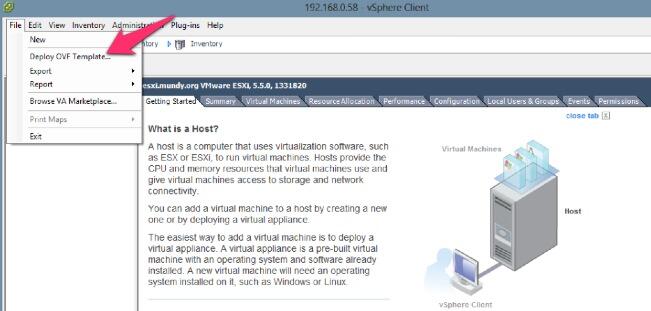
Once the import is finished, you’ll see a new PIAF-Green virtual machine in the Inventory under the IP address of your ESXi server.
4. Start up the new virtual machine by highlighting it and clicking Power on Virtual Machine in the right pane of vSphere Client. You can see it at the bottom of the screenshot below.
5. Open the Virtual Machine Console by clicking on the icon as shown below. Use your mouse to click inside the console window once it opens. Then log in as root with the default password: password.
HINT: To exit from the VM Console window, press Ctrl-Alt simultaneously.
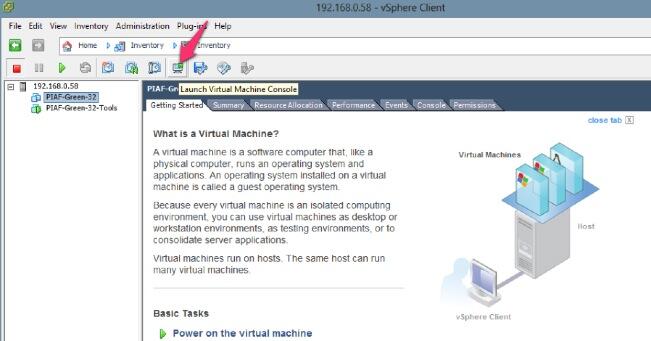
PIAF-Green Virtual Machine Setup Checklist for ESXi
Once you’ve logged into PIAF-Green, you’ll see the status window telling you what’s running and what’s not. It should look something like what’s shown below. It includes the IP address of your virtual machine. This can be used with SSH to log in from any computer on your LAN. It also is required information to log in to the PIAF and FreePBX GUIs using a browser.
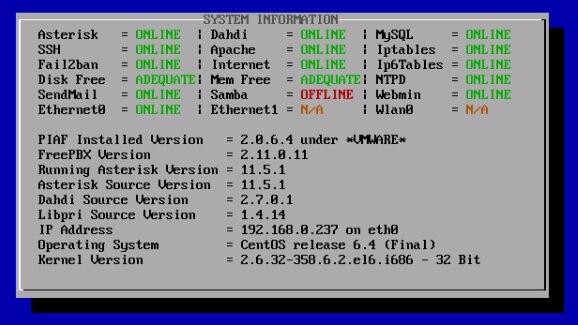
Here’s what you need to know. To work in the PIAF Virtual Machine from the vSphere Console, just left-click your mouse while it is positioned inside the VM Console window. To return to your host operating system desktop, press Ctrl-Alt. Remember to always shut down PIAF gracefully! Click in the VM Console window with your mouse, log in as root, and type: shutdown -h now.
Run ESXi and Virtual Machines behind a hardware-based firewall with no Internet port exposure!
Here’s the quick PIAF Setup Checklist:
- Change your root password immediately by typing passwd
- Set up a secure maint password for FreePBX: passwd-master
- Adjust your timezone setting: /root/timezone-setup
- Decipher your PIAF-Green VM’s IP address: status
- Browser log into PIAF: Point to IP address of PIAF-Green VM
- Click on User button to display the PIAF Admin menu
- Click on the FreePBX icon to load FreePBX GUI
- When prompted for Apache username and password: Username=maint
- Password is whatever password you set up with passwd-master
Now read the latest PIAF Quick Start Guide and begin your VoIP adventure.
You can read all about the Incredible PBX 11 and Incredible Fax feature set in our recent Nerd Vittles article. If you decide you’d like to add one or both to your PIAF-Green Virtual Machine, just log into your server as root and issue the following commands. NOTE: You must install Incredible Fax after installing Incredible PBX, or you will lose the ability to install Incredible PBX at a later time. With Incredible Fax, there are a number of prompts during the install. With the exception of the prompt asking for your local area code, just press Enter at every other prompt.
cd /root
wget http://incrediblepbx.com/incrediblepbx11.gz
gunzip incrediblepbx11.gz
chmod +x incrediblepbx11
./incrediblepbx11
./incrediblefax11.sh
 The Incredible PBX 11 Inventory. For those that have never heard of The Incredible PBX, here’s the current 11.0 feature set in addition to the base install of PBX in a Flash with the CentOS 6.4, Asterisk 11, FreePBX 2.11, and Apache, SendMail, MySQL, PHP, phpMyAdmin, IPtables Linux firewall, Fail2Ban, and WebMin. Incredible Fax, NeoRouter and PPTP VPNs, and all sorts of backup solutions are still just one command away and may be installed using the scripts included with Incredible PBX 11 and PBX in a Flash. Type help-pbx and browse /root for dozens of one-click install scripts.
The Incredible PBX 11 Inventory. For those that have never heard of The Incredible PBX, here’s the current 11.0 feature set in addition to the base install of PBX in a Flash with the CentOS 6.4, Asterisk 11, FreePBX 2.11, and Apache, SendMail, MySQL, PHP, phpMyAdmin, IPtables Linux firewall, Fail2Ban, and WebMin. Incredible Fax, NeoRouter and PPTP VPNs, and all sorts of backup solutions are still just one command away and may be installed using the scripts included with Incredible PBX 11 and PBX in a Flash. Type help-pbx and browse /root for dozens of one-click install scripts.
- AsteriDex
- CallerID Superfecta (FreePBX Module adds Names to CID Numbers)
- CallWho for Asterisk (Dial 411)
- Digium Phone Support (install-digiphones)
- Preconfigured Email That Works with SendMail and Incredible Fax
- OSS Endpoint Manager
- Extensions (1 preconfigured with random password)
- Festival Server and Festival TTS for Asterisk (festival –server &)
- Flite TTS for Asterisk
- FreePBX Backups
- Google Dictionary by Phone (Dial 333)
- Google News by Phone (Dial 951)
- Google Stocks by Phone (Dial 950)
- Google Voice (FreePBX GV/Motif Module)
- Hotel-Style Wakeup Calls (FreePBX Module)
- Incredible Backups… and Restores (install-incredbackup2)
- ISN: FreeNum SIP Calling from Any Phone
- MeetMe Conference Bridge (just dial C-O-N-F)
- Mondo Full System Backups (install-diskbackup)
- Incredible Fax 11 (/root/incrediblefax11.sh)
- Incremental Daily Backups (install-dailybackup)
- Munin Reports (install-munin)
- NeoRouter VPN Client (nrclientcmd)
- NewsClips from Yahoo
- ODBC Database Support (Dial 222, 223)
- OpenFire Instant Messaging & Chat Server (install-openfire)
- New PBX in a Flash Registry (show-registry)
- PPTP VPN for PIAF (/root/install-pptp)
- Reminders by Phone and Web
- SAMBA Windows Networking (configure-samba)
- SMS Dictator with Google Voice (Dial S-M-S)
- Speech-to-Text Directory Assistance (Dial 411)
- Stealth AutoAttendant
- TFTP Server (setup-tftp)
- Tide Reports with xTide (Dial T-I-D-E)
- Travelin’ Man 2 & 3 (Secure, remote access)
- Trunks (Vitelity, Gtalk, SIPgate, IPkall, VoIP.ms, and more)
- Weather by ZIP Code
- Worldwide Weather by Phone (Dial 949)
- Wolfram Alpha by Phone (/root/wolfram)
Unlike the dedicated machine platforms and OpenVZ compromises of years past, today’s PIAF-Green Virtual Machine is state-of-the-art giving you everything a bare metal install from source code would have provided. Most importantly, the components are truly portable. They can be exported and copied to an external USB drive or flash drive for instant portability for use on any ESXi server.
Installing VMware Tools (optional). If you wish to install VMware Tools in your Virtual Machine, here’s the two-step procedure. First, enable the tools in vSphere Client: VM -> Guest -> Install VMware Tools. See image below. Then log in to your virtual machine in the console and issue the following commands:
cd /mnt
mkdir cdrom
mount /dev/cdrom /mnt/cdrom
cd /tmp
tar zxvf /mnt/cdrom/VMware*
cd vmware-tools-distrib
./vmware-install.pl
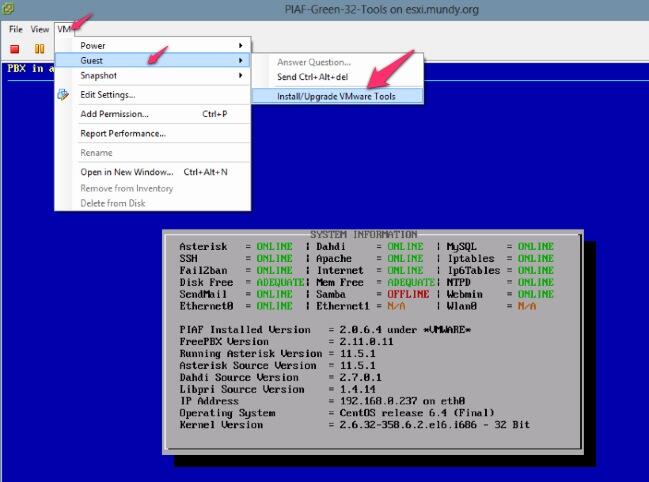
Introducing vSphere Hypervisor 5.5 (ESXi)
We’re late to the party (again), but VMware’s latest ESXi platform is quite impressive. Because there’s a free version, we wanted to walk through the installation scenario just in case you have a spare (beefy) server sitting around gathering dust. Security is always our primary concern, and you are well-advised to install ESXi behind a secure, hardware-based firewall with no Internet port exposure to your ESXi server or its virtual machines!
There are dozens of VMware products and add-ons for the ESXi platform. Almost all of them cost money, lots of it. If your company is considering a move to VMware, then the free ESXi platform is a good way to get your feet wet. Before you make purchasing decisions, you really need to hire a VMware consultant. It could save you tens of thousands of dollars.
For today, our focus is getting a free ESXi platform in place to run PBX in a Flash virtual machines. Here’s what you’ll need: a server, the vSphere Hypervisor 5.5 ESXi ISO, a free license for ESXi, and the vSphere Client for Windows. All are free, but you do have to register for an account on the VMware web site. A web client is also available for dedicated Mac and Linux users. See the VMware site for details.
ESXi comes with a short-term license to let you try the application. Once you register for an account on the VMware web site, you also can obtain a full license here at no cost. Don’t put it off. Once your short-term eval license expires, you’re dead in the water unless you previously have installed the free, unrestricted license.
Installing ESXi. Here are the steps to get yourself in the (free) ESXi business:
- Download the ESXi ISO and burn it to a CD/DVD
- Obtain permanent license key from VMware
- Boot your server from the CD and answer the (easy) prompts
- When install finishes, remove CD and reboot
- Start up ESXi and log in as root with your new password
- Write down the IP address of your server
- Your temporary license key (only) is now active
- Using a browser, access your ESXi server by its IP address
- Click on the provided link to download and install the vSphere Client
- Open vSphere Client on Windows Desktop and login as root with same password
Registering Your ESXi License Key. Once the vSphere Client is open on your desktop…
- Select Configuration tab
- Click Software and choose Licensed Features
- Click Edit link in the top right hand corner as shown below
- Choose: Assign a new license key to this host
- Enter the license key you obtained from VMware
- Click OK to save your changes
- Make sure your key was accepted and is displayed
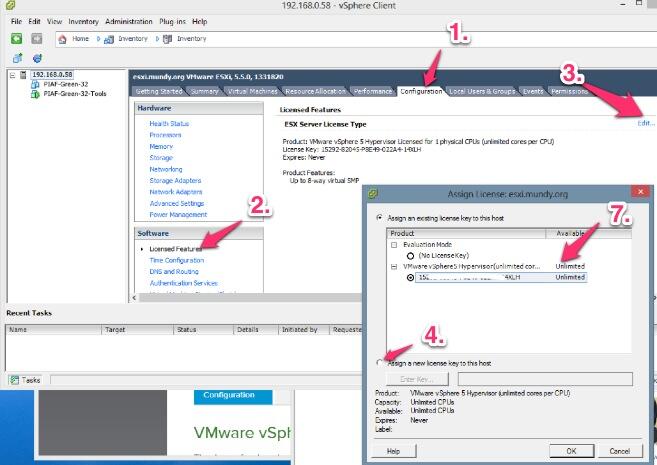
Getting Support. If you need help or have tips with regard to this tutorial, please visit this thread on the PIAF Forum and post your comments. Enjoy!
Deals of the Week. There are a couple of amazing deals still on the street, but you’d better hurry. First, for new customers, Sangoma is offering a board of your choice from a very impressive list at 75% off. For details, see this thread on the PIAF Forum. Second, a new company called Copy.com is offering 20GB of free cloud storage with no restrictions on file size uploads (which are all too common with other free offers). Copy.com has free sync apps for Windows, Macs, and Linux systems. To take advantage of the offer, just click on our referral link here. We get 5GB of extra storage, too, which will help avoid another PIAF Forum disaster.
Originally published: Tuesday, September 24, 2013

Need help with Asterisk? Visit the PBX in a Flash Forum.

We are pleased to once again be able to offer Nerd Vittles’ readers a 20% discount on registration to attend this year’s 10th Anniversary AstriCon in Atlanta. And, if you hurry, you also can take advantage of the early bird registration discount. Here’s the Nerd Vittles Discount Code: AC13NERD.
Special Thanks to Our Generous Sponsors
FULL DISCLOSURE: ClearlyIP, Skyetel, Vitelity, DigitalOcean, Vultr, VoIP.ms, 3CX, Sangoma, TelecomsXchange and VitalPBX have provided financial support to Nerd Vittles and our open source projects through advertising, referral revenue, and/or merchandise. As an Amazon Associate and Best Buy Affiliate, we also earn from qualifying purchases. We’ve chosen these providers not the other way around. Our decisions are based upon their corporate reputation and the quality of their offerings and pricing. Our recommendations regarding technology are reached without regard to financial compensation except in situations in which comparable products at comparable pricing are available from multiple sources. In this limited case, we support our sponsors because our sponsors support us.
 BOGO Bonaza: Enjoy state-of-the-art VoIP service with a $10 credit and half-price SIP service on up to $500 of Skyetel trunking with free number porting when you fund your Skyetel account. No limits on number of simultaneous calls. Quadruple data center redundancy. $25 monthly minimum spend required. Tutorial and sign up details are here.
BOGO Bonaza: Enjoy state-of-the-art VoIP service with a $10 credit and half-price SIP service on up to $500 of Skyetel trunking with free number porting when you fund your Skyetel account. No limits on number of simultaneous calls. Quadruple data center redundancy. $25 monthly minimum spend required. Tutorial and sign up details are here.
 The lynchpin of Incredible PBX 2020 and beyond is ClearlyIP components which bring management of FreePBX modules and SIP phone integration to a level never before available with any other Asterisk distribution. And now you can configure and reconfigure your new Incredible PBX phones from the convenience of the Incredible PBX GUI.
The lynchpin of Incredible PBX 2020 and beyond is ClearlyIP components which bring management of FreePBX modules and SIP phone integration to a level never before available with any other Asterisk distribution. And now you can configure and reconfigure your new Incredible PBX phones from the convenience of the Incredible PBX GUI.
 VitalPBX is perhaps the fastest-growing PBX offering based upon Asterisk with an installed presence in more than 100 countries worldwide. VitalPBX has generously provided a customized White Label version of Incredible PBX tailored for use with all Incredible PBX and VitalPBX custom applications. Follow this link for a free test drive!
VitalPBX is perhaps the fastest-growing PBX offering based upon Asterisk with an installed presence in more than 100 countries worldwide. VitalPBX has generously provided a customized White Label version of Incredible PBX tailored for use with all Incredible PBX and VitalPBX custom applications. Follow this link for a free test drive!
 Special Thanks to Vitelity. Vitelity is now Voyant Communications and has halted new registrations for the time being. Our special thanks to Vitelity for their unwavering financial support over many years and to the many Nerd Vittles readers who continue to enjoy the benefits of their service offerings. We will keep everyone posted on further developments.
Special Thanks to Vitelity. Vitelity is now Voyant Communications and has halted new registrations for the time being. Our special thanks to Vitelity for their unwavering financial support over many years and to the many Nerd Vittles readers who continue to enjoy the benefits of their service offerings. We will keep everyone posted on further developments.
Some Recent Nerd Vittles Articles of Interest…


 JUST RELEASED: Visit the Incredible PBX Wiki
JUST RELEASED: Visit the Incredible PBX Wiki